GRADE
12
Calculus and Vectors MCV4U
This course builds on students' previous experience with functions and their developing understanding of rates of change. Students will solve problems involving geometric and algebraic representations of vectors and representations of lines and planes in three dimensional space; broaden their understanding of rates of change to include the derivatives of polynomial, sinusoidal, exponential, rational, and radical functions; and apply these concepts and skills to the modelling of real-world relationships. Students will also refine their use of the mathematical processes necessary for success in senior mathematics. This course is intended for students who choose to pursue careers in fields such as science, engineering, economics, and some areas of business, including those students who will be required to take a university-level calculus, linear algebra, or physics course. Co-rerequisite: Grade 12 Advanced Functions MHF4U
TABLE OF CONTENTS
Vectors
Vector Addition Terms: Resultant Vs. Equilibrant
Fill in the blanks: The resultant vector and equilibrant vector have (the) _________ magnitudes and point in the _________ direction.
Solution
Video
The resultant vector and equilibrant vector have the same magnitudes and point in the opposite direction.
(The resultant vector is the net sum of more than one vector, and the equilibrant vector is the opposite vector that would cancel another vector out, equal in magnitude and in the opposite direction.)
(The resultant vector is the net sum of more than one vector, and the equilibrant vector is the opposite vector that would cancel another vector out, equal in magnitude and in the opposite direction.)
Adding Vectors to Find the Resultant Vector: x, y Components
Calculate the magnitude of the unknown vector, 'm' if the resultant is zero. Solution
| Vector | Value |
| A | 25 N [S] |
| B | 10 N [E] |
| C | 8 N [S 20˚ E] |
| M | m N [W ____˚ N] |
Hint
Clear
Info
N[ W˚ N ]
Incorrect Attempts:
CHECK
Hint Unavailable
Split into the x-components and y-components for each...
For the positive directions use: up, right. Then net to zero for each, x... and y... And then put it all together for 'm'...' And calculate the reflex angle in quadrant II... = 34.9 N [W 68.6˚ N]
For the positive directions use: up, right. Then net to zero for each, x... and y... And then put it all together for 'm'...' And calculate the reflex angle in quadrant II... = 34.9 N [W 68.6˚ N]
Adding Vectors to Find the Resultant Vector: Cosine Law (or Sine Law)
A sailboat undergoes a force vector of 50N [N 40˚ W] and a second force vector of 30N [E 10˚ N].

Calculate the resultant vector of the two forces using either the sine or cosine law.
Solution
Video
Hint
Clear
Info
Incorrect Attempts:
CHECK
N
Hint Unavailable
Hint
Clear
Info
Incorrect Attempts:
CHECK
N
Hint Unavailable
Calculate the angle between these forces, and the resultant, and the compass angle (aka the heading) of the resultant.
Solution
Hint
Clear
Info
[ N ˚ W ]
Incorrect Attempts:
CHECK
Hint Unavailable
Hint
Clear
Info
[ N ˚ W ]
Incorrect Attempts:
CHECK
Hint Unavailable
Determine the equilibrant vector to the resultant you calculated previously.
Solution
Hint
Clear
Info
N[ S˚ E ]
Incorrect Attempts:
CHECK
Hint Unavailable
The equilibrant vector is the opposite vector, equal in magnitude in the opposite direction, that would cancel another vector out. The equilibrant vector to the resultant vector 43.6 N [N 3.3˚ W]:
The equilibrant magnitude is 43.6 Newtons...
The equilibrant heading is [S 3.3˚ E]...
∴ The equilibrant vector is 43.6 N [S 3.3˚ E].
Hint
Clear
Info
N[ S˚ E ]
Incorrect Attempts:
CHECK
Hint Unavailable
The equilibrant magnitude is 43.6 Newtons...
The equilibrant heading is [S 3.3˚ E]...
∴ The equilibrant vector is 43.6 N [S 3.3˚ E].
Solving Tension Forces and the Resultant Vector using Sine Law
An 8kg mass is suspended in equilibrium from two massless cables. Cable 1 is attached to a vertical wall at an angle of 10˚ to the horizontal while Cable 2 is attached to the ceiling at an angle of 50˚ to the horizontal. Calculate the tension in each cable.
Solution
Hint
Clear
Info
T1 = T2 =
Incorrect Attempts:
CHECK
N
Hint Unavailable
Hint
Clear
Info
T1 = T2 =
Incorrect Attempts:
CHECK
N
Hint Unavailable
Velocity Vector Addition Tip-to-Tail
A canoe is being paddled 5km/h upstream against a current of 1km/h. A 2km/h crosswind is blowing against the canoe at an angle of 30˚ East from the path of the canoe. Calculate the resultant velocity of the canoe relative to the ground. Solution Video
 |
Hint
Clear
Info
Incorrect Attempts:
CHECK
km/h
Hint Unavailable
Linear Combination using Substitution or Elimination of Equations
Show that the vector can be written as a linear combination of the set {(5, 3), (-2, 2)}
Solution
Hint
Clear
Info
(5, 3) + (-2, 2) = (5, 19)
Incorrect Attempts:
CHECK
Hint Unavailable
Hint
Clear
Info
(5, 3) + (-2, 2) = (5, 19)
Incorrect Attempts:
CHECK
Hint Unavailable
Vectors: Simplifying 3-D Linear Combinations
Simplify the 3-space linear combination and show your answer in terms of , , and using the values below.
Solution
Hint
Clear
Info
Incorrect Attempts:
CHECK
Hint Unavailable
Hint
Clear
Info
Incorrect Attempts:
CHECK
Hint Unavailable
Lines in 3-Space: Vector, Parametric, and Symmetric Equations
Calculate the distance between the two points V(3, 2, -4) and W(11, -7, 8) in 3-space.
Solution
d =
Hint
Clear
Info
Incorrect Attempts:
CHECK
units
Hint Unavailable
d =
Hint
Clear
Info
Incorrect Attempts:
CHECK
units
Hint Unavailable
Linear Combination in R3
Which of the following is a unit vector?
Solution
Remember that unit vectors have magnitude equal to 1.
The only one whose magnitude equals 1 is:
The rest of the choices will not equal 1.
Write the 3-dimensional vector as a linear combination of the unit vectors: , , and Solution
Simplifying with , , and
Given the following information, equals .
Solution
Use substitution...
Linear Combination in R3
Solve for , y, and z in the following equation.
Solution
Hint
Clear
Info
x = y = ━━
z = ━━
Incorrect Attempts:
CHECK
Hint Unavailable
Hint
Clear
Info
x = y = ━━
z = ━━
Incorrect Attempts:
CHECK
Hint Unavailable
Linear Combination in R3
Find the value of so that the vector can be written as a linear combination of the vectors and .
Solution
Hint
Clear
Info
━━
Incorrect Attempts:
CHECK
Hint Unavailable
Hint
Clear
Info
━━
Incorrect Attempts:
CHECK
Hint Unavailable
Linear Combination in R3
Showing your work in your notes, determine whether the vector =〈9, -1, 16〉lies on the plane set by =〈1, 3, -4〉and =〈6, 4, 2〉 Solution
Vector Addition
Calculate given that =〈3, -2〉 and =〈1, 7〉.
Solution
Video
Hint
Clear
Info
( , )
Incorrect Attempts:
CHECK
Hint Unavailable
Hint
Clear
Info
( , )
Incorrect Attempts:
CHECK
Hint Unavailable
Calculate the resultant vector given =〈8, 3〉and =〈-2, 3〉.
Solution
Hint
Clear
Info
( , )
Incorrect Attempts:
CHECK
Hint Unavailable
To calculate the resultant, add the vectors:
Hint
Clear
Info
( , )
Incorrect Attempts:
CHECK
Hint Unavailable
DOT PRODUCT
The Dot Product
The result of a dot product is a(n):
Solution
The dot product is also known as the scalar product.
Two vectors are parallel if the ________ of the vectors equals one, and perpendicular if the ________ of the vectors equals zero.
Solution
Two vectors are parallel if the dot product of the vectors equals one, 1.
Two vectors are perpendicular if the dot product of the vectors equals zero, 0.
Two vectors are perpendicular if the dot product of the vectors equals zero, 0.
 |
Calculate the dot product of the unit vector k,
Solution
Hint
Clear
Info
Incorrect Attempts:
CHECK
Hint Unavailable
Hint
Clear
Info
Incorrect Attempts:
CHECK
Hint Unavailable
Which of the following dot product properties is incorrect?
Solution
All answer choices are true, except for...
Which should be...
The Dot Product of Vector Magnitudes
Calculate the dot product of the following given the magnitudes and angle.
= 5, = -10, θ = 60˚
Solution
Hint
Clear
Info
Incorrect Attempts:
CHECK
Hint Unavailable
Dot product uses the absolute value of the vector magnitudes...
= · · cos(60˚)
= |5| · |-10| · cos(60˚)
= (5)(10) · (0.5)
= 25
Hint
Clear
Info
Incorrect Attempts:
CHECK
Hint Unavailable
= · · cos(60˚)
= |5| · |-10| · cos(60˚)
= (5)(10) · (0.5)
= 25
= 5, = -10, θ = 0˚
Solution
Hint
Clear
Info
Incorrect Attempts:
CHECK
Hint Unavailable
Dot product uses the absolute value of the vector magnitudes...
= · · cos(0˚)
= |5| · |-10| · cos(0˚)
= (5)(10) · (1)
= 50
Hint
Clear
Info
Incorrect Attempts:
CHECK
Hint Unavailable
= · · cos(0˚)
= |5| · |-10| · cos(0˚)
= (5)(10) · (1)
= 50
= 5, = -10, θ = 180˚
Solution
Hint
Clear
Info
Incorrect Attempts:
CHECK
Hint Unavailable
Dot product uses the absolute value of the vector magnitudes...
= · · cos(180˚)
= |5| · |-10| · cos(180˚)
= (5)(10) · (-1)
= -50
Hint
Clear
Info
Incorrect Attempts:
CHECK
Hint Unavailable
= · · cos(180˚)
= |5| · |-10| · cos(180˚)
= (5)(10) · (-1)
= -50
= 5, = -10, θ = 90˚
Solution
Hint
Clear
Info
Incorrect Attempts:
CHECK
Hint Unavailable
Dot product uses the absolute value of the vector magnitudes...
= · · cos(90˚)
= |5| · |-10| · cos(90˚)
= (5)(10) · (0)
= 0
See that the dot product of orthogonal (perpendicular) lines is always zero because of cos(90˚) = 0...
Hint
Clear
Info
Incorrect Attempts:
CHECK
Hint Unavailable
= · · cos(90˚)
= |5| · |-10| · cos(90˚)
= (5)(10) · (0)
= 0
See that the dot product of orthogonal (perpendicular) lines is always zero because of cos(90˚) = 0...
The Dot Product of Vectors
Calculate the dot product of the following
In 2-dimensions: = (1, 2) and = (-3, 4)
Solution
Hint
Clear
Info
Incorrect Attempts:
CHECK
Hint Unavailable
Hint
Clear
Info
Incorrect Attempts:
CHECK
Hint Unavailable
In 3-dimensions: = (1, -2, 3) and = (4, 5, -6)
Solution
Hint
Clear
Info
Incorrect Attempts:
CHECK
Hint Unavailable
Hint
Clear
Info
Incorrect Attempts:
CHECK
Hint Unavailable
Determine the angle θ between the three-dimensional vectors from part 'b' above.
Solution
Hint
Clear
Info
Incorrect Attempts:
CHECK
˚
Hint Unavailable
Hint
Clear
Info
Incorrect Attempts:
CHECK
˚
Hint Unavailable
Diagonal of Parallelogram
Calculate the angles between the diagonals of the parallelogram represented by the vectors below. (Answer in increasing order)
Solution
Hint
Clear
Info
= =
Incorrect Attempts:
CHECK
˚
Hint Unavailable
The diagonals of a parallelogram (we will call m and n), are calculated with vector addition:
Calculate the diagonal vectors
Use the dot product formula to calculate angle...
...And the other angle would be (180˚ - 16.26˚) = 163.74˚
Hint
Clear
Info
= =
Incorrect Attempts:
CHECK
˚
Hint Unavailable
Applications of Dot Product
Calculate if both of and are unit vectors, given the perpendicular vectors below. Reduce fully.
Solution
Hint
Clear
Info
━━
Incorrect Attempts:
CHECK
Hint Unavailable
Hint
Clear
Info
━━
Incorrect Attempts:
CHECK
Hint Unavailable
Perpendicular Vectors in 3-Space using Dot Product
Which vector is perpendicular to both of the following vectors?
Solution
Applications of Dot Product
Calculate the dot product below given that and are unit vectors.
Solution
Hint
Clear
Info
Incorrect Attempts:
CHECK
Hint Unavailable
Since the dot product is distributive, it can be foiled...
Since the dot product has scalar multiplication, and is commutative (a•b = b•a)...
Since the square of a unit vector equals zero, and the dot product of different unit vectors equals zero...
Hint
Clear
Info
Incorrect Attempts:
CHECK
Hint Unavailable
Applications of Dot Product
If determine the magnitude of given the following information:
Solution
Hint
Clear
Info
Incorrect Attempts:
CHECK
Hint Unavailable
Hint
Clear
Info
Incorrect Attempts:
CHECK
Hint Unavailable
Intro to Scalar Projections
The scalar projection of on is equal to the scalar projection of on .
Solution
Since the scalar projection must form a right angle, the scalar projection of on will not equal on
Compare on :
 With on :
With on :

Compare on :
 With on :
With on :

The scalar projection of a on b does not depend on b.
Solution
The length of 'b' does not matter:


Scalar Projection Equation
Given the following vectors, the scalar projection of on equals
Solution
Notice only the magnitude on the bottom changes in a scalar projection since a•b = b•a...
Scalar Projection Application
Solve for the variable given the scalar projection of 'a on b' equals 1.
Solution
x =
Hint
Clear
Info
Incorrect Attempts:
CHECK
Hint Unavailable
Given the scalar projection equals 1...
Solve for x by squaring both sides...
x =
Hint
Clear
Info
Incorrect Attempts:
CHECK
Hint Unavailable
Vector Projections
The formula for a vector projection of a on b is written as:
Solution
Notice that the vector projection is the scalar projection that gets...
...multiplied by the unit vector (which gives the direction) of the second vector in the statement that gets projected onto, i.e. "a on b", in the form:
Determine the Direction Vector using Vector Projection
Determine the direction vector given the following vectors of v on w:
Solution
Direction Cosines and Scalar Projection
Given the vectors below, prove they are perpendicular, , using direction cosines, . (Show your work in your own notes)
Solution
cos α + cos β + cos γ =
Hint
Clear
Info
Incorrect Attempts:
CHECK
Hint Unavailable
Remember that is to x,
is to y,
is to z
The vectors are perpendicular since the direction cosine equals zero.
cos α + cos β + cos γ =
Hint
Clear
Info
Incorrect Attempts:
CHECK
Hint Unavailable
is to y,
is to z
The vectors are perpendicular since the direction cosine equals zero.
Cross Product
Cross Product Test for Parallel and Perpendicular Vectors
Two vectors are parallel if the ________ of the vectors equals zero, otherwise the vectors are always perpendicular (orthogonal).
Solution
Two vectors are parallel if the cross product of the vectors equals zero, 0.
Two vectors are perpendicular if the cross product of the vectors does not equal zero (basically almost any vectors in 3-space).
Two vectors are perpendicular if the cross product of the vectors does not equal zero (basically almost any vectors in 3-space).
 |
The cross product always gives you an orthogonal vector, unless it is equal to zero.
Solution
The cross product is a vector perpendicular to the vectors
Which of the following properties of cross products is incorrect?
Solution
Cross product cannot be used to determine if two vectors are perpendicular -- this is the job of the dot product (equal to zero). The cross product is used to determine the magnitude or value of a perpendicular vector.
All the rules are correct:
Except:
Is not equal (≠)
All the rules are correct: Except: Is not equal (≠)
Cross Product Direction and Right Hand Rule
Given the vectors below.
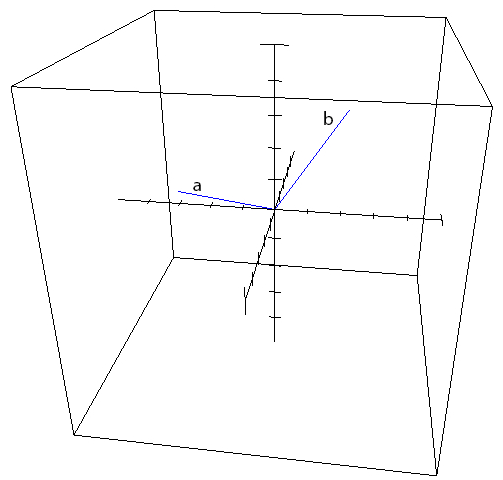
Using the right-hand-rule to determine the direction of the cross product , which parts of the hand are represented by the index finger, middle finger, and thumb?
Solution
Index finger: First vector only
Middle finger: Second vector only
Thumb: Cross product vector only
Middle finger: Second vector only
Thumb: Cross product vector only
Determine the general direction of , up or down.
Solution
Index finger:
Middle finger:
Thumb: → ∴ The thumb points downwards.
Middle finger:
Thumb: → ∴ The thumb points downwards.
Determine the general direction of , up or down.
Solution
Index finger:
Middle finger:
Thumb: → ∴ The thumb points upwards.
Middle finger:
Thumb: → ∴ The thumb points upwards.
Using the right hand rule, determine with the unit vecors...
Solution
i × j, j × k, and k × i
Hint
Clear
Info
i × j =
j × k =
k × i =
Incorrect Attempts:
CHECK
Hint Unavailable
The cross product of unit vectors...
Hint
Clear
Info
i × j =
j × k =
k × i =
j × k =
k × i =
Incorrect Attempts:
CHECK
Hint Unavailable
Simplified 2 × 2 Review of Matrices for Cross Products
The following matrix can be simplified to the determinant:
Solution
True:
Calculate the cross product of the vectors:
Solution
Hint
Clear
Info
Incorrect Attempts:
CHECK
Hint Unavailable
2 × 2 matrix:
Calculate the determinant:
Hint
Clear
Info
Incorrect Attempts:
CHECK
Hint Unavailable
Calculate the magnitude of the vectors:
Solution
Hint
Clear
Info
Incorrect Attempts:
CHECK
Hint Unavailable
The magnitude of 2 × 2 vectors can only be calculated with the formula:
Where the magnitudes are:
The angle is calculated with the cosine of the dot product of m and n, divided by the product of the magnitudes of m and n:
Then calculate this thing finally...
Hint
Clear
Info
Incorrect Attempts:
CHECK
Hint Unavailable
Match the vectors into their correct property.
Solution
Parallel
Perpendicular
Vectors are perpendicular in 3-space unless the cross product equals zero. Calculate the cross products using the 2 × 2 matrix (not shown)..
Parallel
Perpendicular
Cross Product Theory
The equation stated below
Solution
This is the distributive property.
Theory of Scalar and Vector Properties of Cross Product, Dot Product, etc.
Which of the following statements is incorrect?
Solution
"Cross product of a scalar and a vector produces a vector"; there is no such thing.
Any dot product produces a scalar.
Adding vectors produces a vector because they all have directions.
Product of a scalar and a vector produces a vector because the scalar is a multiplication factor of the vector, which maintains its direction.
Any dot product produces a scalar.
Adding vectors produces a vector because they all have directions.
Product of a scalar and a vector produces a vector because the scalar is a multiplication factor of the vector, which maintains its direction.
Cross Product Theory: Direction and the Order of the Cross
Given the vectors below, the cross products are equal:
Solution
First using the right-hand-rule will show the cross products point in different directions. To prove numerically:
Cross product formula in the form and :
Check to see each cross product:
And,
Clearly they are not equal:
This is because they point in opposite directions. Use the right-hand-rule to determine the direction the cross product points.
Cross product formula in the form and : Check to see each cross product: And, Clearly they are not equal: This is because they point in opposite directions. Use the right-hand-rule to determine the direction the cross product points.
Cross Product of Two Vectors
The cross product of the following two vectors can be calculated as...
Solution
This equation is hard to remember:
Cross Product of Two Vectors
It is generally considered conventient to calculate the cross product using matrix notation...
Using matrices to calculate the cross product of two vectors results in which of the following computations?
Solution
Cross product using matrix:
Or you could use the form:
Determine a vector that is orthogonal to the following vectors by calculating the cross product determinant of the matrix.
Solution
Hint
Clear
Info
Incorrect Attempts:
CHECK
Hint Unavailable
Hint
Clear
Info
Incorrect Attempts:
CHECK
Hint Unavailable
Cross Product with Parallelograms
The area of a parallelogram with sides and can be calculated with the following equations, where theta is the angle between the two vectors.
Solution
Given the information below, calculate angle theta . (0 < x < 90˚)
Solution
Hint
Clear
Info
Incorrect Attempts:
CHECK
˚
Hint Unavailable
Cross product
Hint
Clear
Info
Incorrect Attempts:
CHECK
˚
Hint Unavailable
Given three points that lie on a parallelogram, calculate the area of the parallelogram.
Solution
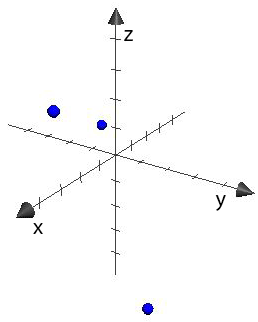 L(1, 2, -5), M(2, -1, 2), N(-2, -2, 0)
Hint
Clear
Info
Incorrect Attempts:
CHECK
units2
Hint Unavailable
First convert the points to vectors (I choose to use LM and LN, but you could use other combinations). Make sure to choose two vectors with the same origin (here the origin is L for both vectors).:
Then calculate the area using the formula, the cross product of the vectors from above (using a matrix here to solve the cross product).
Plug into the formula
Calculate the magnitude of the cross product vector using the formula:
L(1, 2, -5), M(2, -1, 2), N(-2, -2, 0)
Hint
Clear
Info
Incorrect Attempts:
CHECK
units2
Hint Unavailable
First convert the points to vectors (I choose to use LM and LN, but you could use other combinations). Make sure to choose two vectors with the same origin (here the origin is L for both vectors).:
Then calculate the area using the formula, the cross product of the vectors from above (using a matrix here to solve the cross product).
Plug into the formula
Calculate the magnitude of the cross product vector using the formula:
Hint
Clear
Info
Incorrect Attempts:
CHECK
units2
Hint Unavailable
Cross Product with Triangles
The area of a triangle is half the area of a parallelogram. Complete the following using the points below, assuming they all lie on the same plane.
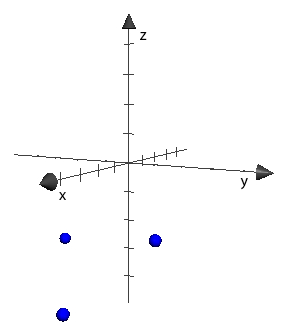 A(1, -2, -8/3), B(4, 0, -4), C(2, 2, -2)
A(1, -2, -8/3), B(4, 0, -4), C(2, 2, -2)
First convert the points to any two vectors. (Use here)
Solution
Hint
Clear
Info
⟨
,
,
⟩
⟨
,
, ━━
⟩
Incorrect Attempts:
CHECK
Hint Unavailable
Make sure to choose two vectors with the same origin (here the origin is B for both vectors).
Hint
Clear
Info
⟨
,
,
⟩
⟨ , , ━━ ⟩
⟨ , , ━━ ⟩
Incorrect Attempts:
CHECK
Hint Unavailable
Calculate the cross product of the vectors .
Solution
Hint
Clear
Info
⟨
━━ ,
━━ ,
⟩
Incorrect Attempts:
CHECK
Hint Unavailable
Set up the matrix
Use the matrix to solve the cross product
Hint
Clear
Info
⟨
━━ ,
━━ ,
⟩
Incorrect Attempts:
CHECK
Hint Unavailable
Determine the magnitude of the vector calculated above, . (Reduce your exact value fully)
Solution
Hint
Clear
Info
Incorrect Attempts:
CHECK
Hint Unavailable
Determine the magnitude of this vector to use for the area...
Hint
Clear
Info
Incorrect Attempts:
CHECK
Hint Unavailable
Calculate the area of the triangle. (Reduce your exact value fully)
Solution
Hint
Clear
Info
Incorrect Attempts:
CHECK
Hint Unavailable
Realize the area of a triangle is half the area of the parallelogram
Plug back in for the area and simplify...
Hint
Clear
Info
Incorrect Attempts:
CHECK
Hint Unavailable
Determine an orthogonal vector to the triangle ABC, using the points from above: A(1, -2, -8/3), B(4, 0, -4), C(2, 2, -2). (Reduce fully)
Solution
Hint
Clear
Info
⟨
━━ i,
━━ j,
k
⟩
Incorrect Attempts:
CHECK
Hint Unavailable
(Answers may vary)
Using the cross product calculated previously, an orthogonal vector is the cross product
(Note that the other cross product not shown is the other orthogonal vector in the opposite direction, )
Hint
Clear
Info
⟨
━━ i,
━━ j,
k
⟩
Incorrect Attempts:
CHECK
Hint Unavailable
Using the cross product calculated previously, an orthogonal vector is the cross product (Note that the other cross product not shown is the other orthogonal vector in the opposite direction, )
Combining the Cross Product and Dot Product
Lets see what happens when there are different combinations of dot products and cross products...
What's calculated first, cross product or dot product?
Solution
Do cross product first, no matter which way it is written:
Or
Calculate
Solution
Hint
Clear
Info
Incorrect Attempts:
CHECK
Hint Unavailable
Do cross product first.
Then do the dot product
Hint
Clear
Info
Incorrect Attempts:
CHECK
Hint Unavailable
Calculate
Solution
Hint
Clear
Info
⟨
,
,
⟩
Incorrect Attempts:
CHECK
Hint Unavailable
Need to calculate the cross product in brackets first ...
So we can simplify to,
Finally calculate the cross product
Hint
Clear
Info
⟨
,
,
⟩
Incorrect Attempts:
CHECK
Hint Unavailable
Combining the Cross Product and Dot Product
The following equation is used to calculate the volume of a parallelepiped.
Solution
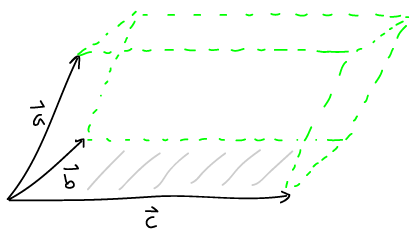
Do the cross product first, followed by the dot product of that cross product you just did. This gives you the area of a parallelogram (the base of the parallelepiped in this case).
Then this area of the bast is dotted with the 'height' of the parallelepiped to give the volume... use the absolute value of this.
Given the vectors: , , and , calculate the volume of the parallelepiped.
Solution
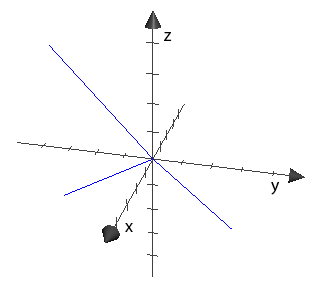 Hint
Clear
Info
Incorrect Attempts:
CHECK
units3
Hint Unavailable
Hint
Clear
Info
Incorrect Attempts:
CHECK
units3
Hint Unavailable
Hint
Clear
Info
Incorrect Attempts:
CHECK
units3
Hint Unavailable
Determine if the following vectors are coplanar, or non-coplanar. (Show your work in your own notes)
Solution
Hint
Clear
Info
Incorrect Attempts:
CHECK
Hint Unavailable
Vectors are coplanar if the volume = 0. (Do cross product first)
Therefore the vectors are non-coplanar.
Hint
Clear
Info
Incorrect Attempts:
CHECK
Hint Unavailable
Application of Cross Product Using Torque
A person applies a 10N force (F) to push open a door. If this person pushes on the door with a radius (r) of 0.45m from the hinges applying a torque (T) of 3.45J, determine the angle in degrees, of the person's force with the door.
Solution
θ =
Hint
Clear
Info
Incorrect Attempts:
CHECK
˚
Hint Unavailable
is the angle between the force (F) and the object that is pushed.
θ =
Hint
Clear
Info
Incorrect Attempts:
CHECK
˚
Hint Unavailable
Lines and Planes
Parametric Equations and Direction Vectors
Determine the direction vector given the following parametric equations:
Solution
The coefficients on 'm'... 5, -3, 7/4
Lines in 2-Space: Vector and Parametric Equations
A line passes through points A(5, 2) and B(1, 10). Determine a direction vector , for this line. (Use proper form with parentheses)
Solution
Hint
Clear
Info
Incorrect Attempts:
CHECK
Hint Unavailable
Hint
Clear
Info
Incorrect Attempts:
CHECK
Hint Unavailable
Lines in 2-Space: Vector and Parametric Equations
A line passing through the point N(1, 5) has a direction vector = (4, -5). Determine the vector equation. (Use proper form with parentheses)
Solution
Hint
Clear
Info
( , ) + t ( , )
Incorrect Attempts:
CHECK
Hint Unavailable
Hint
Clear
Info
( , ) + t ( , )
Incorrect Attempts:
CHECK
Hint Unavailable
Lines in 2-Space: Vector and Parametric Equations
Determine (and in your notes, sketch) two points on the line represented by the vector equation = (1, 4) + t(-2, -2)... for -5 ≤ t ≤ 5. (Use proper form with parentheses) [2]
Solution
Hint
Clear
Info
Incorrect Attempts:
CHECK
Hint Unavailable
Hint
Clear
Info
Incorrect Attempts:
CHECK
Hint Unavailable
Lines in 2-Space: Determine the Angle Between Direction Vectors
Determine the angle between the given direction vectors = (8, 3) and = (-3, 5)
Solution
θ =
Hint
Clear
Info
Incorrect Attempts:
CHECK
˚
Hint Unavailable
θ =
Hint
Clear
Info
Incorrect Attempts:
CHECK
˚
Hint Unavailable
Lines in 2-Space: Vector and Parametric Equations
Given the vector equation = (2, 3) + t(3, -4)
Determine if point C(14, -13) is on the line. (Show your work in your notes)
Solution
Determine the coordinate where the line crosses the y-axis.
Solution
Hint
Clear
Info
Incorrect Attempts:
CHECK
Hint Unavailable
Hint
Clear
Info
Incorrect Attempts:
CHECK
Hint Unavailable
Lines in 2-Space: Vector and Parametric Equations
Given the vector equation = (1, 2) + t(3, 4)
Determine the direction vector of a line , perpendicular to the given vector equation. (Use parenthesis in your answer)
Solution
Hint
Clear
Info
Incorrect Attempts:
CHECK
Hint Unavailable
Hint
Clear
Info
Incorrect Attempts:
CHECK
Hint Unavailable
Determine the vector equation of this perpendicular line if it passes through the point N(5, 6)
Solution
Hint
Clear
Info
( , ) + t ( , )
Incorrect Attempts:
CHECK
Hint Unavailable
Hint
Clear
Info
( , ) + t ( , )
Incorrect Attempts:
CHECK
Hint Unavailable
Lines in 2-Space: Cartesian Equations
Two lines are parallel if their normals are:
The cartesian equation of a line in 2-space is written in the form:
The 'normal' is the same as the:
Solution
Perpendicular line
Lines in 2-Space: Cartesian Equations
Convert the vector equation = (2, 4) + t(6, 8) to:
Slope-y-intercept form. (Reduce fully)
Solution
y =
Hint
Clear
Info
Incorrect Attempts:
CHECK
Hint Unavailable
y =
Hint
Clear
Info
Incorrect Attempts:
CHECK
Hint Unavailable
...Then cartesian form, and then determine the direction vector of the normal
Solution
Hint
Clear
Info
( , )
Incorrect Attempts:
CHECK
Hint Unavailable
Hint
Clear
Info
( , )
Incorrect Attempts:
CHECK
Hint Unavailable
Lines in 2-Space: Cartesian Equations
Given the equations of two lines, 8 + 4y = 2x and 9 - 4y + x = 0, for what value of are the lines perpendicular?
Solution
k =
Hint
Clear
Info
Incorrect Attempts:
CHECK
Hint Unavailable
k =
Hint
Clear
Info
Incorrect Attempts:
CHECK
Hint Unavailable
Lines in 3-Space: Vector, Parametric, and Symmetric Equations
Two vector equations represent the same line when they have only:
Lines in 3-Space: Vector, Parametric, and Symmetric Equations
The ________ of two direction vectors gives you a third direction vector that is perpendicular to the first two.
Lines in 3-Space: Vector, Parametric, and Symmetric Equations
A line passes through the points M(1, 2, 3) and N(4, 5, 6). Determine the two different direction vectors for the line. (Use the given parentheses in your answer) [2]
Solution
Hint
Clear
Info
Incorrect Attempts:
CHECK
Hint Unavailable
Hint
Clear
Info
Incorrect Attempts:
CHECK
Hint Unavailable
Lines in 3-Space: Vector, Parametric, and Symmetric Equations
Given a line that passes through the points P(1, -4, 2) and Q(3, 2, -1) find the:
Vector equation Solution
Parametric equations Solution
Symmetric equations Solution
Lines in 3-Space: Vector, Parametric, and Symmetric Equations
Find the value of k given the two perpendicular direction vectors: = (4, -1, 6) and = (3, -12k, 2k)
Solution
k =
Hint
Clear
Info
━━
Incorrect Attempts:
CHECK
Hint Unavailable
k =
Hint
Clear
Info
━━
Incorrect Attempts:
CHECK
Hint Unavailable
Lines and Planes
A line can intersect a plane: (check all that apply)
Solution
A line can intersect a plane an infinite number of times when the line is on the plane.
Lines and Planes: No Point of Intersection
A line that does not intersect a plane, is proven when:
Solution
When the vector line and the normal of the plane are perpendicular, then the vector line is parallel to the plane.
Lines and Planes: Line on the Plane
A line is verified to be on a plane when:
Solution
There are infinite values for the scalar multiple when the line is 'on' the plane.
Lines and Planes: Finding a Point of Intersection
Determine the point of intersection between the vector = (1, -2, 3) + m(2, 3, 1) and the plane defined below. (Show exact values and reduce fully)
Solution
2x - y + 3z + 4 = 0
Hint
Clear
Info
Incorrect Attempts:
CHECK
Hint Unavailable
Hint
Clear
Info
Incorrect Attempts:
CHECK
Hint Unavailable
Coplanar Vectors in 2-Space
In 2-space, any two noncollinear (not lying on the same straight line) vectors are coplanar.
Solution
In 2-space, the vectors are coplanar.
Lines and Planes: Finding the Point of Intersection
Determine the point(s) of intersection of the following lines: = (0, 1, 2) + m(1, -1, 2) and = (-3, 4, -4) + n(0, 1, 2)
Solution
Hint
Clear
Info
( , , )
Incorrect Attempts:
CHECK
Hint Unavailable
Hint
Clear
Info
( , , )
Incorrect Attempts:
CHECK
Hint Unavailable
 |
The Intersection of a Vector Line and a Plane
Determine the point of intersection between the plane z = 5, and the vector line: x = -1 + s, y = 3 + 2s, and z = 6 + 7s. (Reduce fully)
Solution
Hint
Clear
Info
Incorrect Attempts:
CHECK
Hint Unavailable
Set the two 'z' equations equal, given that z = 5 and z = 6 + 7s... solve for 's',
Substitute 's' value into the parametric equations to solve for 'x', 'y' and 'z'.
...
The point of intersection between the vector and the plane = (x, y, z)
Hint
Clear
Info
Incorrect Attempts:
CHECK
Hint Unavailable
...
The point of intersection between the vector and the plane = (x, y, z)
Intersection of Lines
Skew lines exist in R2 and R3.
Solution
Skew lines are lines that are not parallel and do not intersect. This is not possible in 2D, it is only possible in 3D.
 |
The Intersection of Planes
It is possible for two or more planes to intersect at... (More than one answer: check all that apply)
Solution
If the planes overlap, they would intersect at an infinite number of points. Three planes intersect at one point.
Checking a Solution to a System of Two Equations with Three Unknowns
Determine if the point, (2, 7, 1) is a solution to the system, hence if this is the point of intersection of the following planes:
Solution
Sub (2, 7, -2) into both equations and check if the solutions are the same. If they are not the same, then the given point is not a point of intersection, i.e. not a solution to the system.
Therefore the point, (2, 7, 1) is not a point of intersection (POI) of the given planes.
Solving a System with Three Equations and Three Unknowns
Solve the system, hence determine the point of intersection. (Use exact values and reduce fully)
Solution
Hint
Clear
Info
Incorrect Attempts:
CHECK
Hint Unavailable
Solve using a combination of substitution and elimination, with 3 equations and 3 unknowns... (not shown)
Hint
Clear
Info
Incorrect Attempts:
CHECK
Hint Unavailable
The Intersection of Planes: Parallel Planes
Solve the system, if possible:
Solution
①
②
Planes with the same normal (or scalar multiple of normal) are parallel so they do not intersect and there is no solution to the system. If the last number on the right side of the equal sign was also a scalar multiple, then the two planes would be considered 'coincident', meaning there are an infinite number of solutions because the planes overlap...
The following planes are...
Solution
① Ax + By + Cz + D = 0
② Ax + By + Cz + E = 0
The planes are not 'coincident' (overlapping) because the last values ('D', 'E') differ. Since the planes have the same normals (A, B, C) but different constants at the end, then they are only parallel.
[Note that "coplanar" is typically only used when describing whether or not 'points' lie on the same plane.]
[Note that "coplanar" is typically only used when describing whether or not 'points' lie on the same plane.]
The Intersection of Planes: Concept
Which of the following statements about plane intersection is false?
Solution
While planes can intersect along a continuous line, they cannot intersect at a single point in space.
The Intersection of Two Cartesian (Scalar) Planes; Equation of a Line of Intersection
Solve the system, if possible:
Solution
①
②
Notice that the normal of the two equations are not equal, meaning the planes are not parallel. Normals are found from the coefficients of the equation when written only in standard (Cartesian) form:
Also note that if the planes are parallel and the constant on the right side of the Cartesian equation is the same in both, then the planes are coincident with infinite number of solutions or intersection points. Also note that two planes intersect along a line, and not at a single point.
To solve, we solve for one variable and introduce a parameter. Right away we can solve for x...
Sub ① in ②
Substituting 'x' into one of the equations, we get a solution to this system of planes in the form of an equation of a line of intersection:
Other forms are accepted:
To solve, we solve for one variable and introduce a parameter. Right away we can solve for x... Sub ① in ② Substituting 'x' into one of the equations, we get a solution to this system of planes in the form of an equation of a line of intersection: Other forms are accepted:
The Intersection of Planes: Equation of the Line of Intersection of Planes Passing Through a Point
Determine the equation of a line that passes through the point N(1, 2, 3) and is parallel to the equation of the line of intersection of the following planes that are in Cartesian form:
Solution
The line of intersection is perpendicular to the normals of both planes: (2, 1, -1) and (3, 2, 0). To find the direction vector of the line that is perpendicular to both normals - the line of intersection - we can take the cross product as follows:
A line parallel to the line of intersection will have the same direction vector, . The parametric equations can be found by combining the point N(1, 2, 3) and the direction vector .
x = 1 + 3s
y = 2 - 5s
z = 3 + 1s
The line equation can also be written in vector form:
A line parallel to the line of intersection will have the same direction vector, . The parametric equations can be found by combining the point N(1, 2, 3) and the direction vector .
x = 1 + 3s
y = 2 - 5s
z = 3 + 1s
The line equation can also be written in vector form:
Vector Equations of Planes
Plane Vector Equations Basics
Two planes have the 'normal vectors' below. Determine the relationship between the two planes.
Solution
[Some of these statements are impossible.] Note that the normal vectors are scalar multiples, therefore the vectors are considered collinear, and the planes are considered parallel. [We do not have enough information to determine whether the planes are coplanar.]
Converting Plane Equations from Vector to Scalar (Cartesian)
Convert the following vector plane equation into its scalar, Cartesian form.
Solution
First determine the 'normal' from the cross product of the direction vectors:
This gives you part of the constants in the Cartesian equation:
Now solve for 'D', by substituting the position vector...
0 = 7x - 25y + z + 39
Vector Equation of a Plane (Derived from Points)
Determine the vector equation and parametric equations of a plane, from the points: A(0, 3, 1), B(8, 5, -2), and C(3, -4, 0).
Solution
Determine two coplanar vectors:
[Note that other combinations of coplanar vectors could have been used above, e.g. ]
Next, use any of the points on the plane, to make the vector equation. A vector equation consists of the position vector, scalar multiples, and two coplanar vectors...
The parametric equation forms are:
Next, use any of the points on the plane, to make the vector equation. A vector equation consists of the position vector, scalar multiples, and two coplanar vectors... The parametric equation forms are:
Determine whether the point D(11, -2, 7) is on the plane defined previously.
Solution
Substitute the point into the parametric equations, and simplify each:
Substitution
Substitution
Finally, use 's', 't' and the last 'z' equation to check if LS = RS.
Therefore the point is not on the plane. [Note that points can be found by substituting arbitrary scalar multiple values into the plane equation.]
Vector Equation of a Plane (Derived from Two Vector Equations of Lines)
Determine the plane vector equation from the given line vector equations below.
Solution
See that the direction vectors (2, 5, -1), and (4, 10, -2) of the line equations are parallel..
Since the direction vectors of the line equations are parallel, then we cannot use both of these direction vectors for our plane equation. Instead, we can find one new direction vector from the subtraction of the given position vectors (3, 4, 5), and (0, 1, 3). [Note that the order doesn't matter much]
We use any position vector point on the plane, along with our two coplanar, non-parallel direction vectors:
Vector Equations of Planes
Given the following vector equations of planes:
Determine the normals to each plane equation.
Solution
Get the normal from the cross product of the direction vectors.
Determine whether the planes are coplanar.
Solution
First check if the planes are at least parallel. Planes are parallel when their normals are collinear. [If the planes are not parallel then they are definitely not coplanar] Get the normal from the cross product of the direction vectors.
Since the normals are scalar multiples of eachother, then we can conclude that the two planes are at least parallel. Finally, check if the planes are coplanar by substituting the position vector from one plane, into the other plane equation, to see if (L.S. = R.S.).
Get one more equation... And then substitute 's' into it...
Therefore the planes are coplanar.
Distances
The Distance from a Point to a Line in 2-Dimensions
Calculate the distance between the point N(1, 5) and a line with the equation 3x + y - 4 = 0. (Reduce your exact answer fully)
Solution
d =
Hint
Clear
Info
━━
Incorrect Attempts:
CHECK
Hint Unavailable
Write the equation in Cartesian form: Ax + By + C = 0
Use the point (X, Y)
d =
Hint
Clear
Info
━━
Incorrect Attempts:
CHECK
Hint Unavailable
Use the point (X, Y)
Find the distance between a point M(2, 3) and a line with vector equation = (1, -8) + s(4, 6). (Reduce your exact answer fully)
Solution
d =
Hint
Clear
Info
Incorrect Attempts:
CHECK
Hint Unavailable
Convert the vector into Cartesian form: x = 1 + 4s and y = -8 + 6s
Substitute for 's'
6x - 4y - 33 = 0
Use the point (X, Y)
d =
Hint
Clear
Info
Incorrect Attempts:
CHECK
Hint Unavailable
Substitute for 's'
6x - 4y - 33 = 0
Use the point (X, Y)
Calculating the Distance Between Two Parallel Lines in 2-Dimensions
Find the shortest distance between two parallel lines. Round your answer to the nearest decimal place.
Solution
d =
Hint
Clear
Info
Incorrect Attempts:
CHECK
Hint Unavailable
First make any point out of one of the line equations. It is easiest to choose a y-intercept or x-intercept.
E.g. sub x = 0 into the top equation: 3(0) - y - 7 = 0
y = - 7
Point: (0, -7)
Then sub this point and the other line equation into the distance formula....
d =
Hint
Clear
Info
Incorrect Attempts:
CHECK
Hint Unavailable
E.g. sub x = 0 into the top equation: 3(0) - y - 7 = 0
y = - 7
Point: (0, -7)
Then sub this point and the other line equation into the distance formula....
The Distance Between a Point and a Line in 3-Dimensions
Calculate the shortest distance from the point N(2, 8, 5) and a line with equation = (2, 5, -1) + s(1, -5, 3). (Reduce your exact answer fully)
Solution
d =
Hint
Clear
Info
Incorrect Attempts:
CHECK
Hint Unavailable
First find = P - N = [ 2 - 2, 5 - 8, -1 - 5 ] = (0, -3, -6)
Use the direction vector given in the equation = (1, -5, 3)
The new distance equation uses the given point 'N' and the point on the vector 'P'. Notice that the numerator involves the cross product between the direction vector and the line 'NP'.
d =
Hint
Clear
Info
Incorrect Attempts:
CHECK
Hint Unavailable
Use the direction vector given in the equation = (1, -5, 3)
The new distance equation uses the given point 'N' and the point on the vector 'P'. Notice that the numerator involves the cross product between the direction vector and the line 'NP'.
The Distance Between a Point and a Plane
Find the shortest distance from the point P(6, 7, 8) to the plane: 2x + 3y - 4z + 5 = 0
Solution
d =
Hint
Clear
Info
Incorrect Attempts:
CHECK
Hint Unavailable
Sub the point P(6, 7, 8) and equation 2x + 3y - 4z + 5 = 0 into the new distance equation for planes:
x = 6
y = 7
z = 8
A = 2
B = 3
C = -4
D = 5
d =
Hint
Clear
Info
Incorrect Attempts:
CHECK
Hint Unavailable
x = 6
y = 7
z = 8
A = 2
B = 3
C = -4
D = 5
The Distance Between Two Parallel Planes
Find the distance between the planes
Solution
d =
Hint
Clear
Info
Incorrect Attempts:
CHECK
Hint Unavailable
First we must find a point (x, y, z) on one of the planes, and use this with the other plane equation in the distance formula.
To find a point on the plane, it is easiest to find an x, y, or z intercept.
(E.g.) to find the x-intercept, plug y=0 and z=0 into one of the equations.
x - 3y + 4z + 2 = 0 → x - 3(0) + 4(0) + 2 = 0 → x = -2
Now we have the point P(-2, 0, 0) and the other equation x - 3y + 4z - 5 = 0
x = -2, y = 0, z = 0, A = 1, B = -3, C = 4, D = -5.
d =
Hint
Clear
Info
Incorrect Attempts:
CHECK
Hint Unavailable
To find a point on the plane, it is easiest to find an x, y, or z intercept.
(E.g.) to find the x-intercept, plug y=0 and z=0 into one of the equations.
x - 3y + 4z + 2 = 0 → x - 3(0) + 4(0) + 2 = 0 → x = -2
Now we have the point P(-2, 0, 0) and the other equation x - 3y + 4z - 5 = 0
x = -2, y = 0, z = 0, A = 1, B = -3, C = 4, D = -5.
The Distance Between Lines that are Not Parallel and Do Not Intersect, in 3-Dimensions
Find the shortest distance between the skew lines.
Solution
d =
Hint
Clear
Info
Incorrect Attempts:
CHECK
Hint Unavailable
The shortest distance between the two skew lines is the magnitude of a third vector connecting the two lines. This third vector is perpendicular to both skew lines.
and
and
Direction (position) vector of positions P1, P2:
Cross product of or or , either way you will get the same answer in the end...
Scalar projection of the position vector, , onto the cross product, or ...
d =
Hint
Clear
Info
Incorrect Attempts:
CHECK
Hint Unavailable
and Direction (position) vector of positions P1, P2: Cross product of or or , either way you will get the same answer in the end... Scalar projection of the position vector, , onto the cross product, or ...
Limits and Continuity
Limits
Simple Limits
Solve the following limits, which are rather simple.
Solution
Hint
Clear
Info
Incorrect Attempts:
CHECK
Hint Unavailable
Sub 1 into the equation
Hint
Clear
Info
Incorrect Attempts:
CHECK
Hint Unavailable
Solution
Hint
Clear
Info
Incorrect Attempts:
CHECK
Hint Unavailable
The limit cannot be undefined, so first it must be simplified or manipulated:
Hint
Clear
Info
Incorrect Attempts:
CHECK
Hint Unavailable
Limit Properties
A limit, exists only when,
Solution
If the limit (dependent, y-value) was not the same on either side of 'n', then the limit, does not exist.
Limit Properties
The limit, exists.
Solution
If the limit (dependent, y-value) was not the same on either side of 'n', then the limit, does not exist.
While the function is defined at x = 3, and exists, the limit from the negative side, does not exist (D.N.E.). Therefore, since the limit on either side is not the same (DNE & 0), then DNE.
While the function is defined at x = 3, and exists, the limit from the negative side, does not exist (D.N.E.). Therefore, since the limit on either side is not the same (DNE & 0), then DNE.
Limits
For the limit:
Explain why the limit exists (as x approaches zero).
Solution
While one would assume that the limit would be undefined because the denominator would be zero, the fraction can be algebraically manipulated so that the denominator is not only “x.” The limit exists at all points where the slope is defined (for example, not at: cusps, inflection points, or discontinuities). Remember that the limit gives you the slope at a point, or if a point is not given, then it's just the equation of the slope.
Solve the limit.
Solution
Hint
Clear
Info
━━
Incorrect Attempts:
CHECK
Hint Unavailable
Solve, using the conjugate,
Hint
Clear
Info
━━
Incorrect Attempts:
CHECK
Hint Unavailable
Limits
Solve the limits.
Solution
Hint
Clear
Info
━━
Incorrect Attempts:
CHECK
Hint Unavailable
Hint
Clear
Info
━━
Incorrect Attempts:
CHECK
Hint Unavailable
Solution
Hint
Clear
Info
━━
Incorrect Attempts:
CHECK
Hint Unavailable
Hint
Clear
Info
━━
Incorrect Attempts:
CHECK
Hint Unavailable
Solution
Hint
Clear
Info
Incorrect Attempts:
CHECK
Hint Unavailable
Hint
Clear
Info
Incorrect Attempts:
CHECK
Hint Unavailable
Solution
Hint
Clear
Info
━━
Incorrect Attempts:
CHECK
Hint Unavailable
Hint
Clear
Info
━━
Incorrect Attempts:
CHECK
Hint Unavailable
Solution
Hint
Clear
Info
Incorrect Attempts:
CHECK
Hint Unavailable
Divide everything by a factor of 'x'..
Hint
Clear
Info
Incorrect Attempts:
CHECK
Hint Unavailable
Solution
Hint
Clear
Info
Incorrect Attempts:
CHECK
Hint Unavailable
First, use the difference of squares procedure, essentially by multiplying by 1,
[Tricky] Common factor the x2 under the root to take it out of the root, and at the same time, put 'x's in the denominator
Then, Divide the numerator and denominator by x,
Simplify,
Hint
Clear
Info
Incorrect Attempts:
CHECK
Hint Unavailable
Limits using Change of Variable
To denationalize the denominator in the function below, we can multiply both the numerator and denominator by the conjugate, as shown.
Solution
Multiplying by the conjugate is typically only useful to derationalize the denominator for square roots, like:
Therefore, a different technique, called 'Change of Variable' must be used...
Determine the following.
Solution
Hint
Clear
Info
Incorrect Attempts:
CHECK
Hint Unavailable
Let 't' = , and write 'x' in terms of 't'
Find, as x -> 0, t -> ?
Now, substitute into the limit, and factor the difference of cubes:
Hint
Clear
Info
Incorrect Attempts:
CHECK
Hint Unavailable
Limits
Determine the values for the cubic function below (where a, b, c ∈ R and a, b, c ≠ 0).
Given the following information:Determine the value of c.
Solution
c =
Hint
Clear
Info
Incorrect Attempts:
CHECK
Hint Unavailable
Calculate ƒ(0),
Since as stated above ƒ(0) = 2,
c =
Hint
Clear
Info
Incorrect Attempts:
CHECK
Hint Unavailable
Determine the value of a and b given the information above.
Solution
Hint
Clear
Info
a = ━━
b = ━━
Incorrect Attempts:
CHECK
Hint Unavailable
Determine an equation for a using given information
Determine an equation for b using given information
Substitute a (found earlier) into the equation to solve for b.
Substitute b into the equation found earlier to solve for a.
Hint
Clear
Info
a = ━━
b = ━━
b = ━━
Incorrect Attempts:
CHECK
Hint Unavailable
Limits
Find a linear equation that satisfies the following two conditions:
Solution
y =
Hint
Clear
Info
Incorrect Attempts:
CHECK
Hint Unavailable
(2, 3) is a coordinate, and (1,1) is also a coordinate !
The other equation
Subtract the two equations (using elimination), the slope is:
The y-intercept:
The equation is:
y =
Hint
Clear
Info
Incorrect Attempts:
CHECK
Hint Unavailable
Limits
The amount of bacteria, b, in hundreds, on a piece of moldy cheese, in time, t hours, can be represented by the following piecewise function:
Determine the limit,
Solution
Hint
Clear
Info
Incorrect Attempts:
CHECK
Hint Unavailable
Hint
Clear
Info
Incorrect Attempts:
CHECK
Hint Unavailable
Determine the limit,
Solution
Hint
Clear
Info
━━━
Incorrect Attempts:
CHECK
Hint Unavailable
Hint
Clear
Info
━━━
Incorrect Attempts:
CHECK
Hint Unavailable
The cheese is thrown out after 10 hours. Determine the highest number of bacteria.
Solution
Hint
Clear
Info
Incorrect Attempts:
CHECK
Hint Unavailable
Calculate b(10):
The highest number of bacteria is 15300 (since the amount of bacteria, b, is in hundreds).
Hint
Clear
Info
Incorrect Attempts:
CHECK
Hint Unavailable
Sketch b(t).
Solution
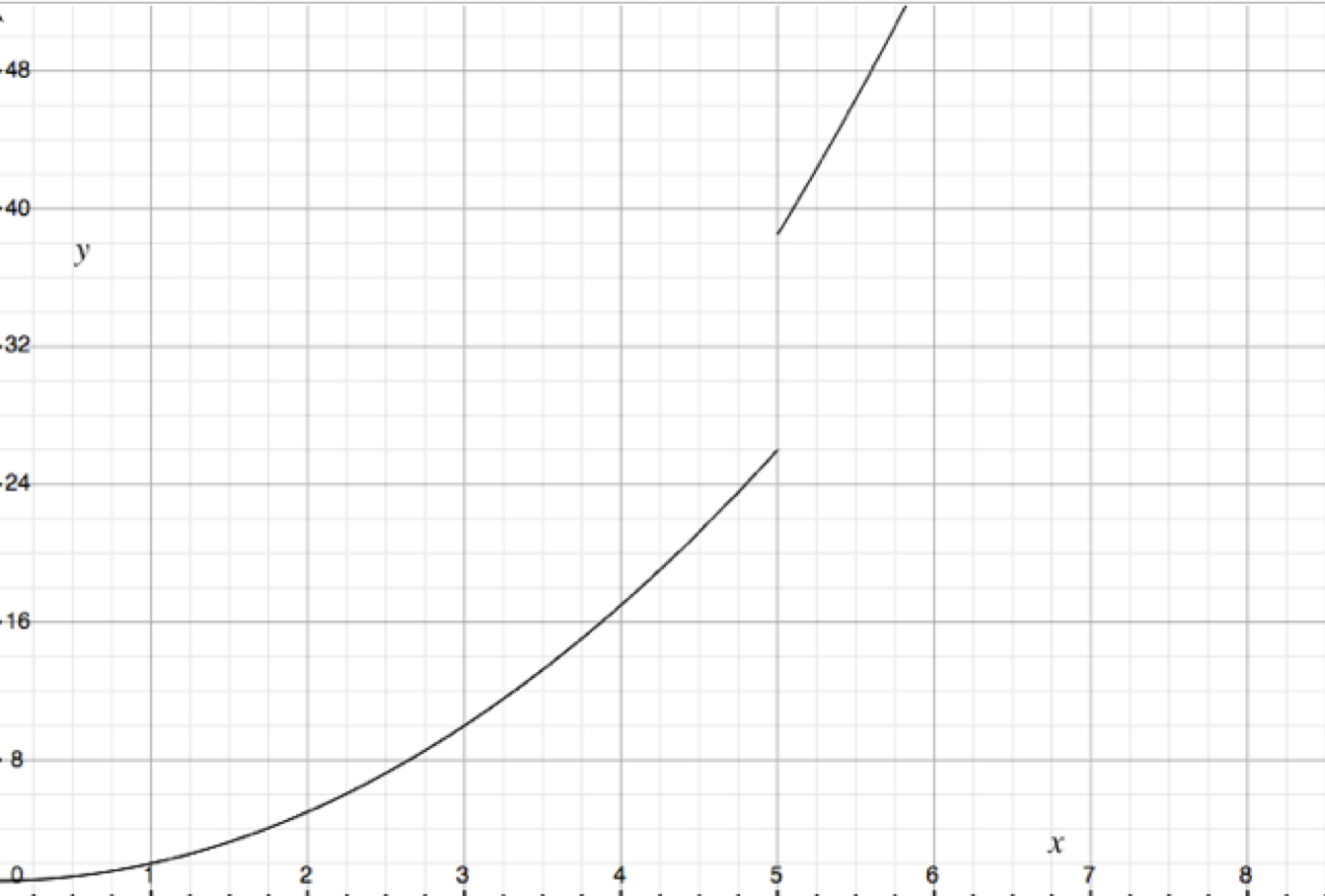

Limits
Determine the limit with the information below.
Solution
Limit Properties
Determine if the following is true or false.
Solution
A limit can be broken up and expanded into component functions.
Limit Properties
Using the following statements for the questions below.
- , for any constant k
- for any constant c
Which statement(s) is (are) true?
Solution
Any coefficient can be brought outside of a limit and limits of functions can be broken into separate components.
Correct any incorrect properties.
Solution
The correct version of III:
The 'a' value should not be multiplied into the limit.
For each correct property, demonstrate it (them) with an example
Solution
I) the limit of a constant is the same constant:
II) notice each evaluates to 13:
Continuity
Continuity or Discontinuity when Limit Exists or DNE
For each of the following sketches of piecewise functions, determine whether the function is continuous at point 'a' and whether the limit exits as 'x' approaches 'a'.
If a piecewise function is discontinuous at point 'x = a' then the Does Not Exist (DNE), always.
Solution
False, even if a piecewise function is discontinuous at 'a', occasionally the limit exists as 'x' approaches 'a'.
Solution

- Continuity: The piecewise function is discontinuous at 'a' because you would have to lift a pen off of the function, to trace along its path.
- Limit: The limit Does Not Exist (DNE) because The 'y' values are not the same for either side of 'a':
- Continuity: The piecewise function is discontinuous at 'a' because you would have to lift a pen off of the function, to trace along its path.
- Limit: The limit Does Not Exist (DNE) because The 'y' values are not the same for either side of 'a':
Solution

- Continuity: The piecewise function is discontinuous at 'a' because you would have to lift a pen off of the function, to trace along its path.
- Limit: The limit Does Not Exist (DNE) because The 'y' values are not the same for either side of 'a':
- Continuity: The piecewise function is discontinuous at 'a' because you would have to lift a pen off of the function, to trace along its path.
- Limit: The limit Does Not Exist (DNE) because The 'y' values are not the same for either side of 'a':
Solution

- Continuity: The piecewise function is discontinuous at 'a' because you would have to lift a pen off of the function, to trace along its path.
- Limit: The limit Exists because The 'y' values are the same for either side of 'a' (as 'x' approaches 'a'):
- Continuity: The piecewise function is discontinuous at 'a' because you would have to lift a pen off of the function, to trace along its path.
- Limit: The limit Exists because The 'y' values are the same for either side of 'a' (as 'x' approaches 'a'):
Solution

- Continuity: The piecewise function is continuous at 'a' because you don't have to lift a pen off of the function, to trace along its path. All real values of 'x' exist in the domain of the piecewise function.
- Limit: The limit Exists because The 'y' values are the same for either side of 'a' (as 'x' approaches 'a'):
- Continuity: The piecewise function is continuous at 'a' because you don't have to lift a pen off of the function, to trace along its path. All real values of 'x' exist in the domain of the piecewise function.
- Limit: The limit Exists because The 'y' values are the same for either side of 'a' (as 'x' approaches 'a'):
Solution

This piecewise function is actually a combination of three functions, one of which is a point that would would like (y = -5, for x = a)...
- Continuity: The piecewise function is discontinuous at 'a' because you would have to lift a pen off of the function, to trace along its path.
- Limit: The limit Exists because The 'y' values are the same for either side of 'a' (as 'x' approaches 'a'):
- Continuity: The piecewise function is discontinuous at 'a' because you would have to lift a pen off of the function, to trace along its path.
- Limit: The limit Exists because The 'y' values are the same for either side of 'a' (as 'x' approaches 'a'):
Continuity
ƒ(x) is continuous at “a” for all of the conditions except for which of the following?
Solution
If ƒ(a) is a defined point at “a,” that means that the function must continue, so ƒ(x) must be continuous at “a.” A limit approaching "a" from either side is always the same as long as there is not a sudden brake in the function, so the statement in "b" must apply to a continuous function as well. For a continuous function, there are no asymptotes or holes, so the limit as x approaches "a" must always be equal to f(a) and therefore the function is not continuous for the condition outlined in option c.
Continuity
Identify the four continuous functions below.
Solution
a) Continuous because ƒ(a) is defined for any point “a”
b) Not continuous because at x=1 the exponent is undefined
c) Not continuous because it is undefined at x=1
d) The absolute value is a trick and does not affect the continuity of the function. The function is defined at all points.
e) The function has a hole at x = 1. Since x < 1, there is no hole, so the function is continuous:
f) Since x > 1, there is a hole, so the function is not defined at x = 1, and therefore not continuous
g) Continuous because ƒ(a) is defined for any point “a”
h) Not continuous because it has asymptotes at such that n ∈ Ζ.
b) Not continuous because at x=1 the exponent is undefined
c) Not continuous because it is undefined at x=1
d) The absolute value is a trick and does not affect the continuity of the function. The function is defined at all points.
e) The function has a hole at x = 1. Since x < 1, there is no hole, so the function is continuous: f) Since x > 1, there is a hole, so the function is not defined at x = 1, and therefore not continuous
g) Continuous because ƒ(a) is defined for any point “a”
h) Not continuous because it has asymptotes at such that n ∈ Ζ.
Continuity
The following piecewise function is continuous.
Solution
There is a break at x = 1.
The following piecewise function is continuous at x = -3.
Solution
See that the second function has a vertical asymptote at x = -3
From a quick sketch [not shown] of the piecewise functions, you can see there is a discontinuity at x = -3.
Continuity Constants
Given the following continuous piecewise function, determine the value 'k'
Solution
Hint
Clear
Info
━━
Incorrect Attempts:
CHECK
Hint Unavailable
For the function to be continuous at 'x = 6' the y-values must be the same at that point.
Hint
Clear
Info
━━
Incorrect Attempts:
CHECK
Hint Unavailable
Given the following continuous piecewise function, determine the values 'h' and 'k'
Solution
Hint
Clear
Info
h = k =
Incorrect Attempts:
CHECK
Hint Unavailable
For the function to be continuous at some point of 'x' the y-values must be equal at that point.
At x = 1,
At x = 4,
Sub 1 equation into the other,
Solve for 'h'
Hint
Clear
Info
h = k =
Incorrect Attempts:
CHECK
Hint Unavailable
At x = 1, At x = 4, Sub 1 equation into the other, Solve for 'h'
Rate of Change
Instantaneous and Average Rates of Change (Without Difference Quotient)
Given the function ƒ(x) = x4 - x3, determine:
the average rate of change on the interval -3 ≤ x ≤ 1
Solution
Hint
Clear
Info
Incorrect Attempts:
CHECK
Hint Unavailable
Hint
Clear
Info
Incorrect Attempts:
CHECK
Hint Unavailable
the instantaneous rate of change at x = -5
Solution
Hint
Clear
Info
Incorrect Attempts:
CHECK
Hint Unavailable
Hint
Clear
Info
Incorrect Attempts:
CHECK
Hint Unavailable
Instantaneous Rate of Change at the Vertex of a Quadratic Function (Without Difference Quotient)
For the function ƒ(x) = 3(x - 4)2 + 1
Estimate the instantaneous rate of change at the vertex, without using difference quotient.
Solution
Hint
Clear
Info
Incorrect Attempts:
CHECK
Hint: Slope at the vertex point.
Hint
Clear
Info
Incorrect Attempts:
CHECK
Hint: Slope at the vertex point.
Determine the average rate of change from x = 2 to x = 8.
Solution
Hint
Clear
Info
Incorrect Attempts:
CHECK
Hint Unavailable
Hint
Clear
Info
Incorrect Attempts:
CHECK
Hint Unavailable
Average Rate of Change for a Trig Function
For the function ƒ(x) = 8sin(x), calculate the exact value of the average rate of change (AROC) on the interval [0, 90]
Solution
Hint
Clear
Info
━━
Incorrect Attempts:
CHECK
Hint Unavailable
Hint
Clear
Info
━━
Incorrect Attempts:
CHECK
Hint Unavailable
Estimating Instantaneous Rate of Change for a Trig Function
For the function ƒ(x) = 6sin(30x) + 10, estimate the instantaneous rate of change (IROC), at x = 2
Solution
Hint
Clear
Info
Incorrect Attempts:
CHECK
Hint Unavailable
Hint
Clear
Info
Incorrect Attempts:
CHECK
Hint Unavailable
Instantaneous Rate of Change (Limit of Difference Quotient)
Given the function ƒ(x) = 2x - 4x2, find the slope of the tangent using the difference quotient, at x = -2.
Solution
m =
Hint
Clear
Info
Incorrect Attempts:
CHECK
Hint Unavailable
m =
Hint
Clear
Info
Incorrect Attempts:
CHECK
Hint Unavailable
Instantaneous Rate of Change (Limit of Difference Quotient)
A baseball is launched into the air and its height can be modelled by the function h(t) = -5t2 + 15t + 1, where h(t) is height in metres, and t is time in seconds. Determine the exact instantaneous rate of change in the height of the baseball at 2s.
Solution
s =
Hint
Clear
Info
Incorrect Attempts:
CHECK
m/s
Hint Unavailable
Use the difference quotient, at t = 2, as h --> 0
s =
Hint
Clear
Info
Incorrect Attempts:
CHECK
m/s
Hint Unavailable
Equation of a Line using Instantaneous Rate of Change (Difference Quotient)
Determine the equation of the line, in slope-y-intercept form, that passes through the point P(1, 2) and is parallel to the line tangent to the function below, at the point P(7, 5). (Solve using the limit of the difference quotient.)
Solution
y =
Hint
Clear
Info
Incorrect Attempts:
CHECK
Hint Unavailable
First, determine the slope at x = 7, with the limit of the difference quotient,
Then just use this slope with the given point to determine the linear equation, using the slope 'm', from the limit, and the point P(1, 2)
Therefore the equation is,
y =
Hint
Clear
Info
Incorrect Attempts:
CHECK
Hint Unavailable
Slope and Instantaneous Rate of Change (Difference Quotient)
Determine the exact slope of the curve of the function below, at the point where x = -5.
Solution
m =
Hint
Clear
Info
━━
Incorrect Attempts:
CHECK
Hint Unavailable
m =
Hint
Clear
Info
━━
Incorrect Attempts:
CHECK
Hint Unavailable
Instantaneous Rate of Change Word Problems
The growth of a cellular culture is modeled by the function below, where 't' is time in days, and g(x) is mass in mg. Determine the rate of change of the mass with respect to time, on the 32nd day.
Solution
Hint
Clear
Info
Incorrect Attempts:
CHECK
mg/day
Hint Unavailable
Determine the rate of change by taking the limit, at t = 32,
Hint
Clear
Info
Incorrect Attempts:
CHECK
mg/day
Hint Unavailable
For a cylinder that has a height 'h' double its radius 'r', determine the rate of change of volume with respect to radius, when the radius is 10 cm. [Diagram not to scale]
Solution
 Hint
Clear
Info
Incorrect Attempts:
CHECK
cm3/cm
Hint Unavailable
For volume of a cylinder
Determine the instantaneous rate of change using the difference quotient,
Hint
Clear
Info
Incorrect Attempts:
CHECK
cm3/cm
Hint Unavailable
For volume of a cylinder
Determine the instantaneous rate of change using the difference quotient,
Hint
Clear
Info
Incorrect Attempts:
CHECK
cm3/cm
Hint Unavailable
Instantaneous Rate of Change Word Problems
Linear density is a measurement of the change in mass of a material, over a length.
d(x) represents the mass (in kg) of a water pipe along its length (in m), over 0 < x < 50 m,Determine the (instantaneous) linear density at 25 m.
Solution
Hint
Clear
Info
Incorrect Attempts:
CHECK
Hint Unavailable
Linear density is a rate of change of mass over length, and is the slope of the function ...
Hint
Clear
Info
Incorrect Attempts:
CHECK
Hint Unavailable
Motion Using Limits
Given the position function, where s(t) is position in meters, at time 't' in seconds.
Determine the average velocity from 2.0 to 6.0 seconds.
Solution
Hint
Clear
Info
Incorrect Attempts:
CHECK
m/s
Hint Unavailable
Hint
Clear
Info
Incorrect Attempts:
CHECK
m/s
Hint Unavailable
Determine the instantaneous velocity at time, 4.0 seconds.
Solution
Hint
Clear
Info
Incorrect Attempts:
CHECK
m/s
Hint Unavailable
Hint
Clear
Info
Incorrect Attempts:
CHECK
m/s
Hint Unavailable
Motion Using Limits
Given the functions for position, s(t), and velocity, v(t) determine the values of the constants 'h' and 'k' if the instantaneous velocity at 1.0 s is 2 m/s.
Solution
Hint
Clear
Info
h = k =
Incorrect Attempts:
CHECK
Hint Unavailable
Given the instantaneous velocity at 1.0 s is 2 m/s,
Therefore the velocity is,
Solve for the constant 'k' with the limit,
Now set this equal to the equation determined previously,
So either,
Therefore k = 12, and,
Hint
Clear
Info
h = k =
Incorrect Attempts:
CHECK
Hint Unavailable
Derivatives (Differentiation)
Power Rule Theory
State whether the following is true or false.
Solution
Video
We have to subtract 1 from the exponent:
Differentiation
True or false?
Solution
Video
Differentiate to check, and then see that you can common factor out a 5...
Determine the original equation for 'y' given
Solution
⁰
¹
²
³
⁴
⁵
⁶
⁷
⁸
⁹
⁻
⁺
⁽
⁾
₀
₁
₂
₃
₄
₅
₆
₇
₈
₉
₋
₊
₍
₎
Incorrect Attempts:
CHECK
Hint Unavailable
Use the following to understand. If,
⁰
¹
²
³
⁴
⁵
⁶
⁷
⁸
⁹
⁻
⁺
⁽
⁾
₀
₁
₂
₃
₄
₅
₆
₇
₈
₉
₋
₊
₍
₎
Incorrect Attempts:
CHECK
Hint Unavailable
Derivative Properties
Given ƒ(x) = a(x) + b(x), determine a’(x) if:
Solution
Video
Hint
Clear
Info
Incorrect Attempts:
CHECK
Hint Unavailable
Since ƒ(x) = a(x) + b(x),
ƒ’(x) = a’(x) + b’(x)
Substitute the givens and solve for a’(x) = -1
Hint
Clear
Info
Incorrect Attempts:
CHECK
Hint Unavailable
ƒ’(x) = a’(x) + b’(x) Substitute the givens and solve for a’(x) = -1
Slope of a Tangent to a Curve
Determine the slope of the tangent to , at x = 1.
Solution
Hint
Clear
Info
Incorrect Attempts:
CHECK
Hint Unavailable
Differentiate using power rule,
At x = 1,
Hint
Clear
Info
Incorrect Attempts:
CHECK
Hint Unavailable
Equation of a Normal to a Curve
Determine the equation of the normal, in slope-y-intercept form, to the function
Solution
Video
Hint
Clear
Info
Incorrect Attempts:
CHECK
Hint Unavailable
The derivative is the slope (equation) of the tangent
Determine the slope of the tangent at x = 3
The normal is perpendicular to the tangent (slope is a negative reciprocal).
We need a point on the normal, which intersects the original like so determine the point using the original function (which we will use on the function of the normal).
Sub this point and find b and the equation of the normal:
Hint
Clear
Info
Incorrect Attempts:
CHECK
Hint Unavailable
Chain Rule.. f ∘ g(x) = ƒ(g(x)) = ƒ'[g(x)] · g'(x)
Differentiate.
Solution
Video
For some function, using the Chain Rule like,
So,
Chain Rule
Differentiate
Solution
Video
Hint
Clear
Info
Incorrect Attempts:
CHECK
Hint Unavailable
Using the chain rule
Hint
Clear
Info
Incorrect Attempts:
CHECK
Hint Unavailable
Differentiate . (Don't expand or simplify your answer)
Solution
Video
⁰
¹
²
³
⁴
⁵
⁶
⁷
⁸
⁹
⁻
⁺
⁽
⁾
₀
₁
₂
₃
₄
₅
₆
₇
₈
₉
₋
₊
₍
₎
Incorrect Attempts:
CHECK
Hint Unavailable
⁰
¹
²
³
⁴
⁵
⁶
⁷
⁸
⁹
⁻
⁺
⁽
⁾
₀
₁
₂
₃
₄
₅
₆
₇
₈
₉
₋
₊
₍
₎
Incorrect Attempts:
CHECK
Hint Unavailable
Chain Rule
Differentiate, use a calculator do evaluate your values.
Given, determine, g'(1).
Solution
Hint
Clear
Info
Incorrect Attempts:
CHECK
Hint Unavailable
Using chain rule, multiple times,
So,
Hint
Clear
Info
Incorrect Attempts:
CHECK
Hint Unavailable
Given, determine, f'(1).
Solution
Hint
Clear
Info
Incorrect Attempts:
CHECK
Hint Unavailable
Hint
Clear
Info
Incorrect Attempts:
CHECK
Hint Unavailable
Chain Rule with Leibniz Notation
Leibniz Notation is one way to apply the chain rule. Differentiate, using Leibniz Notation, find .
Solution
⁰
¹
²
³
⁴
⁵
⁶
⁷
⁸
⁹
⁻
⁺
⁽
⁾
₀
₁
₂
₃
₄
₅
₆
₇
₈
₉
₋
₊
₍
₎
Incorrect Attempts:
CHECK
Hint Unavailable
inner: let 'u' = 3x2 - 2
outer: let 'y' = u2
⁰
¹
²
³
⁴
⁵
⁶
⁷
⁸
⁹
⁻
⁺
⁽
⁾
₀
₁
₂
₃
₄
₅
₆
₇
₈
₉
₋
₊
₍
₎
Incorrect Attempts:
CHECK
Hint Unavailable
outer: let 'y' = u2
, at x = 1.
Solution
Hint
Clear
Info
Incorrect Attempts:
CHECK
Hint Unavailable
Rearrange, to use chain rule later,
inner: let 'u' = 3x2 - 2x1/2
outer: let 'y' = u-1
So,
Hint
Clear
Info
Incorrect Attempts:
CHECK
Hint Unavailable
outer: let 'y' = u-1 So,
Leibniz Notation
Using Leibniz notation, differentiate for 'y' in terms of 'x' given the following.
Solution
Hint
Clear
Info
Incorrect Attempts:
CHECK
Hint Unavailable
Leibniz:
Substitute 'u'
Substitute 'x'
Hint
Clear
Info
Incorrect Attempts:
CHECK
Hint Unavailable
Using Leibniz notation, differentiate for 'y' in terms of 'x' given the following.
Solution
Hint
Clear
Info
Incorrect Attempts:
CHECK
Hint Unavailable
Rearrange 'u', in order to use chain rule for
Use quotient rule when differentiating 'dy' by 'du'
Substitute 'x' into 'u'
Substitute 'x' and 'u' into the original equation
Hint
Clear
Info
Incorrect Attempts:
CHECK
Hint Unavailable
Using Leibniz notation, determine at x = 3, given the following information.
Solution
Hint
Clear
Info
Incorrect Attempts:
CHECK
Hint Unavailable
First get 'u' in terms of 'x'
Then, using Leibniz notation,
Then substitute 'u', then 'x',
Hint
Clear
Info
Incorrect Attempts:
CHECK
Hint Unavailable
The Product Rule
Differentiate.
, and determine f'(0).
Solution
Video
Hint
Clear
Info
Incorrect Attempts:
CHECK
Hint Unavailable
The Product Rule:
Plug everything into the product rule:
Simplifying more is sometimes optional:
Then substitute f'(0),
Hint
Clear
Info
Incorrect Attempts:
CHECK
Hint Unavailable
, and determine f'(0).
Solution
Hint
Clear
Info
Incorrect Attempts:
CHECK
Hint Unavailable
Using the product rule
Then, determine f'(0)
Hint
Clear
Info
Incorrect Attempts:
CHECK
Hint Unavailable
Techniques
For the function , which of the three statements are correct?
Solution
- Only the chain and product rules must be used to differentiate ƒ(x)
To differentiate ƒ(x), the product rule must be used, and to find the component derivatives, the chain rule must be used. Therefore I is correct.
Therefore II is correct.
Therefore III is incorrect, so the correct answer is b.
- Only the chain and product rules must be used to differentiate ƒ(x)
The Quotient Rule
Differentiate , for f'(0).
Solution
Video
Hint
Clear
Info
Incorrect Attempts:
CHECK
Hint Unavailable
Differentiate using quotient rule,
So,
Hint
Clear
Info
Incorrect Attempts:
CHECK
Hint Unavailable
Quotient Rule with Other Rules
Differentiate.
, where a = 2, b = 3, and c = 4.
Solution
Hint
Clear
Info
Incorrect Attempts:
CHECK
Hint Unavailable
This mainly combines the product rule and quotient rule (and power rule).
Where
Differentiate,
Where a = 2, b = 3, and c = 4...
Hint
Clear
Info
Incorrect Attempts:
CHECK
Hint Unavailable
at x = 1.
Solution
Hint
Clear
Info
Incorrect Attempts:
CHECK
Hint Unavailable
Start out with the chain rule,
Then apply the quotient rule to the interior, let
So,
At x = 1,
Hint
Clear
Info
Incorrect Attempts:
CHECK
Hint Unavailable
, at x = 20.
Solution
Hint
Clear
Info
Incorrect Attempts:
CHECK
Hint Unavailable
Use quotient rule, in the form,
Differentiate,
Simplify, [simplification steps may vary]
At, x = 20
Hint
Clear
Info
Incorrect Attempts:
CHECK
Hint Unavailable
Differentiation Techniques
Differentiate and determine the indicated values, using a calculator.
Differentiate , and determine f'(2).
Solution
Hint
Clear
Info
Incorrect Attempts:
CHECK
Hint Unavailable
Differentiate,
Then,
Hint
Clear
Info
Incorrect Attempts:
CHECK
Hint Unavailable
Differentiate , and determine .
Solution
Hint
Clear
Info
Incorrect Attempts:
CHECK
Hint Unavailable
You can either use chain rule with a negative exponent, or quotient rule [neither shown here] to eventually get,
So,
Hint
Clear
Info
Incorrect Attempts:
CHECK
Hint Unavailable
Differentiate , and determine g'(0).
Solution
Hint
Clear
Info
Incorrect Attempts:
CHECK
Hint Unavailable
You can either use chain rule with a negative exponent, or quotient rule [neither shown here]...
g(x) can be expressed as :
So,
Hint
Clear
Info
Incorrect Attempts:
CHECK
Hint Unavailable
g(x) can be expressed as : So,
Differentiation with Compositions and Combinations of Functions
Determine given the following.
Solution
Hint
Clear
Info
Incorrect Attempts:
CHECK
Hint Unavailable
Understand the notation,
First determine,
Differentiate b(x),
So,
Then,
Hint
Clear
Info
Incorrect Attempts:
CHECK
Hint Unavailable
Determine the value of 'x' given the following.
Solution
Hint
Clear
Info
Incorrect Attempts:
CHECK
Hint Unavailable
First,
So,
And since,
Then,
Hint
Clear
Info
Incorrect Attempts:
CHECK
Hint Unavailable
Differentiation Word Problems
A medication is metabolized in the body and the concentration, in mg/L, in the bloodstream is given by c(t), where 't' is in hours. For t > 0.5 hr, determine f'(8), and interpret it in your own notes.
Solution
Hint
Clear
Info
Incorrect Attempts:
CHECK
Hint Unavailable
Differentiate,
Substitute,
Hint
Clear
Info
Incorrect Attempts:
CHECK
Hint Unavailable
A hamburger store can sell 120 hamburgers per week at $4.00 per hamburger. For each $0.50 decrease in price, they can sell 20 more hamburgers. Determine the ‘marginal revenue’ function in terms of 'x'.
Solution
Hint
Clear
Info
Incorrect Attempts:
CHECK
Hint Unavailable
Let 'x be the number of changes,
Marginal revenue,
Hint
Clear
Info
Incorrect Attempts:
CHECK
Hint Unavailable
Modeling Derivatives (Motion, Optimization)
Multiple Derivatives
Differentiate:
Find ƒ’(x).
Solution
Find ƒ’’(x).
Solution
Find ƒ’’’(x).
Solution
Multiple Derivatives
Determine ƒ''(2) given ƒ(x) below.
Solution
Motion: Position
An object is moving in a straight line. Its position, s is shown on the graph below as it varies with time t. We define the 'right' as the positive direction. When is it moving to the right?
Solution

If the object is moving to the right, the slope of the graph must be increasing.
Motion: Velocity
An object is moving in a straight line. Its velocity, v is shown on the graph below as it varies with time t.

When is it decelerating?
Solution
The acceleration on a velocity time graph is the slope at a certain point, which can be found with the derivative. It is only decelerating when the derivative is negative, so the answer is c.
Motion: Acceleration
An object is moving in a straight line. Its acceleration, a is shown on the graph below as it varies with time t. When is velocity constant?
Solution

Acceleration is the derivative of velocity so velocity is only constant when acceleration is at zero (at the x-axis). Therefore, the answer is b.
Motion Graph Comparison (Position, Velocity, Acceleration)
The 1-dimensional motion of an object is tracked on the three graphs: position s(t), velocity v(t), and acceleration a(t). The motion is mapped over the phases A - F, and the points I - VII. [The positive direction is defined as 'to the right', and the position is comprised of piecewise, quadratic motions].

All the phases where the object is slowing down are in phase 'B' and 'D', and speeding up are in phase 'C', 'E', and 'F'.
Solution
The object is slowing down in phase 'B' and 'D' and speeding up in phase 'A', 'C', 'E', and 'F'.
The negative velocity in phases 'A - D' always means the object is moving backwards, to the left, towards the reference (zero) position.
Solution
False. In phase 'D' the object is moving to the left, but is moving away from the reference (zero) position.
Where is the motion fastest?
Solution
The motion is fastest where velocity is the highest magnitude, which is phase 'F' or point 'VII'.
At which three points is the object stopped?
Solution
The object is stopped where the slope is horizontal on the position graph, or where velocity equals zero, at points: 'I', 'III', and 'V'
At which point does the object turn around?
Solution
The object turns around at point 'V' where it is moving away from its origin, at the x-axis, and then back towards it.
Over which two phases does the object transition from slowing down in the negative direction to speeding up in the negative direction.
Solution
- In phase 'B' the object is slowing down (approaching a horizontal slope on the position graph, or approaching the x-axis on the velocity graph), in the negative direction (negative slope on the position graph).
- In phase 'C' the object is speeding up (changing from a horizontal slope to a steeper slope on the position graph, or moving away from the x-axis on the velocity graph), in the negative direction (negative slope on the position graph).
- In phase 'B' the object is slowing down (approaching a horizontal slope on the position graph, or approaching the x-axis on the velocity graph), in the negative direction (negative slope on the position graph).
- In phase 'C' the object is speeding up (changing from a horizontal slope to a steeper slope on the position graph, or moving away from the x-axis on the velocity graph), in the negative direction (negative slope on the position graph).
For your own edification, fill out the table below, in your own notes. One of the rows is provided to you, as an example. Solution
| Phase | v(t) | a(t) | v(t) × a(t) | Description of Motion |
| A | ||||
| B | ||||
| C | ||||
| D | — | + | — | Slowing down, in the negative direction (to the left) |
| E | ||||
| F | ||||
| G |
The product of velocity and acceleration, v(t) × a(t), indicates the speed:
- Speeding up: v(t) × a(t) > 0
- Stopped: v(t) × a(t) = 0
- Slowing down: v(t) × a(t) < 0
| Phase | v(t) | a(t) | v(t) × a(t) | Description of Motion |
| A | — | — | + | Speeding up, in the negative direction (to the left) |
| B | — | + | — | Slowing down, in the negative direction (to the left) |
| C | — | — | + | Speeding up, in the negative direction (to the left) |
| D | — | + | — | Slowing down, in the negative direction (to the left) |
| E | + | + | + | Speeding up, in the positive direction (to the right) |
| F | + | + | + | Speeding up, in the positive direction (to the right) |
Motion
Displacement (d) is the change in position (∆s).
True or false? (Where a is acceleration, v is velocity, s is position)
Solution
To manipulate the variables, it is better to express velocity as a derivative of position.
Therefore,
By canceling out, , which is correct.
Therefore, the answer is true.
Therefore,
By canceling out, , which is correct. Therefore, the answer is true.
Given that s is position, v is velocity, and a is acceleration in time t, it is true that: a(t) = s'''(t).
Solution
Velocity is the change in position, so v = s'(t).
Acceleration is the change in velocity over a given time, so a = s''(t).
Therefore the answer is false.
Acceleration is the change in velocity over a given time, so a = s''(t).
Therefore the answer is false.
Motion
A bird flies in a straight line with position s in meters after t seconds represented by the equation:
Find the exact distance travelled within the first 5 seconds. Reduce fully.
Solution
d =
Hint
Clear
Info
━━
Incorrect Attempts:
CHECK
m
Hint Unavailable
d =
Hint
Clear
Info
━━
Incorrect Attempts:
CHECK
m
Hint Unavailable
Determine the velocity at 6 seconds.
Solution
v =
Hint
Clear
Info
Incorrect Attempts:
CHECK
m/s
Hint Unavailable
Velocity, v is the derivative of position, s.
v =
Hint
Clear
Info
Incorrect Attempts:
CHECK
m/s
Hint Unavailable
Find the intervals for which the velocity is positive and negative, for t ≥ 0.
Solution
Given the equation for velocity from before:
Negative (when velocity is < 0):
Positive (when velocity is > 0):
Find the acceleration. Reduce fully.
Solution
a
Hint
Clear
Info
━━
Incorrect Attempts:
CHECK
m/s2
Hint Unavailable
Acceleration is the derivative of velocity:
a
Hint
Clear
Info
━━
Incorrect Attempts:
CHECK
m/s2
Hint Unavailable
Motion
For a moving object where s is position, v is velocity, and k and h are constants such that k, h ∈ℝ. Given the equations for displacement and velocity:
Solve for k and h. Reduce fully.
Solution
Hint
Clear
Info
h = ━━ k = ━━
Incorrect Attempts:
CHECK
Hint Unavailable
By differentiating s(t), you get velocity, v(t)
Set the two velocity equations equal
Hint
Clear
Info
h = ━━ k = ━━
Incorrect Attempts:
CHECK
Hint Unavailable
Determine the acceleration of the object.
Solution
a =
Hint
Clear
Info
Incorrect Attempts:
CHECK
m/s2
Hint Unavailable
a =
Hint
Clear
Info
Incorrect Attempts:
CHECK
m/s2
Hint Unavailable
Multiple Derivatives
At the maximum value of ƒ(x)...
Solution
At the maximum point on a graph, the graph must be stationary (critical point), and thus the slope at that point must be zero. Therefore, options b and c are eliminated because the slope, ƒ’(x) = 0
At the maximum point, the second derivative, ƒ’’(x) must be decreasing because the slope is `decreasing` where the function is concave down.
At the maximum point, the second derivative, ƒ’’(x) must be decreasing because the slope is `decreasing` where the function is concave down.
Motion
A ball is thrown vertically from the ground of an unknown planet. Its position, s in meters above the ground at t seconds is modeled by the following function:
At what time does the ball reach maximum height?
Solution
t =
Hint
Clear
Info
━━
Incorrect Attempts:
CHECK
s
Hint Unavailable
t =
Hint
Clear
Info
━━
Incorrect Attempts:
CHECK
s
Hint Unavailable
What is the maximum height?
Solution
h =
Hint
Clear
Info
Incorrect Attempts:
CHECK
m
Hint Unavailable
h =
Hint
Clear
Info
Incorrect Attempts:
CHECK
m
Hint Unavailable
What is the acceleration due to gravity on this planet?
Solution
a =
Hint
Clear
Info
Incorrect Attempts:
CHECK
m/s2
Hint Unavailable
a =
Hint
Clear
Info
Incorrect Attempts:
CHECK
m/s2
Hint Unavailable
Motion
The height 's(t)' of a projectile over time 't' is modeled by the function below.
Determine the average velocity from 1.0 to 6.0 seconds.
Solution
Hint
Clear
Info
Incorrect Attempts:
CHECK
m/s
Hint Unavailable
Hint
Clear
Info
Incorrect Attempts:
CHECK
m/s
Hint Unavailable
Determine the velocity the second time that the height equals 26 m.
Solution
Hint
Clear
Info
Incorrect Attempts:
CHECK
m/s
Hint Unavailable
First determine the time 't' when the height is 26 m
The second time that the height is 26 m, is at 5 seconds. Next, use this and the derivative of 's(t)', which is the velocity 'v(t)'
Hint
Clear
Info
Incorrect Attempts:
CHECK
m/s
Hint Unavailable
Determine the change in position from 0.5 to 3.5 seconds.
Solution
Hint
Clear
Info
Incorrect Attempts:
CHECK
Hint Unavailable
Hint
Clear
Info
Incorrect Attempts:
CHECK
Hint Unavailable
Maxima and Minima
Determine the coordinates of the extreme values of the following functions.
Solution
Hint
Clear
Info
Incorrect Attempts:
CHECK
Hint Unavailable
Take the derivative
At an extreme value, ƒ'(x) = 0
Determine the coordinate
Therefore the coordinate is
Hint
Clear
Info
Incorrect Attempts:
CHECK
Hint Unavailable
Solution
Hint
Clear
Info
Incorrect Attempts:
CHECK
Hint Unavailable
Take the derivative using the Quotient Rule
At an extreme value, ƒ'(x) = 0
Extreme values:
Hint
Clear
Info
Incorrect Attempts:
CHECK
Hint Unavailable
Maxima and Minima Word Problems
A big-time sports manager would like to maximize his revenue, r by choosing the correct amount of jersey’s, in thousands, to produce, which can be represented by the value, j. The amount of revenue made per jersey can be represented by the following function below. How many jerseys should the manager make?
Solution
Hint
Clear
Info
Incorrect Attempts:
CHECK
jerseys
Hint Unavailable
Since “j” is in thousands, the manager should produce 2,750 jerseys.
Hint
Clear
Info
Incorrect Attempts:
CHECK
jerseys
Hint Unavailable
A book store is trying to maximize its revenue. The price for a book on average is $25.00. During an average week, 80 books are sold. A recent survey indicates that for every $1.00 decrease in price, 4 more books are sold every week. Calculate the price that will maximize the revenue.
Solution
$
Hint
Clear
Info
Incorrect Attempts:
CHECK
Hint Unavailable
We must determine an expression. Let “r” be revenue and “b” the number of dollar decreases.
At maximum revenue, r'(b) = 0, therefore
The price should be reduced by $2.50 (since b = 2.5). Therefore, the price should be decreased to $22.50
$
Hint
Clear
Info
Incorrect Attempts:
CHECK
Hint Unavailable
 |
Optimization
Optimization: Using Similar Triangles
A straight section of railroad crosses two roads at points that are 800 m and 1200 m from an intersection. Find the dimensions of the largest rectangular lot that can be laid out in the triangle formed by the railroad and roads in terms of x.
Solution
 Hint
Clear
Info
Incorrect Attempts:
CHECK
m
You need two equations; one from similar triangles, the other from area. You need to differentiate for Area.
Let the dimensions of the rectangular lot be, “x” and “y”.
Hint
Clear
Info
Incorrect Attempts:
CHECK
m
You need two equations; one from similar triangles, the other from area. You need to differentiate for Area.
Let the dimensions of the rectangular lot be, “x” and “y”.
Using similar triangles, starting with a rectangle that fits with a height of 'y' and a width of 'x',
Calculate the area in terms of x:
The max occurs when the derivative (A‘) equals zero,
Find 'y'
When x = 600, y = 400, the maximum dimensions are 600 m x 400 m
Hint
Clear
Info
Incorrect Attempts:
CHECK
m
You need two equations; one from similar triangles, the other from area. You need to differentiate for Area.
Using similar triangles, starting with a rectangle that fits with a height of 'y' and a width of 'x', Calculate the area in terms of x: The max occurs when the derivative (A‘) equals zero, Find 'y' When x = 600, y = 400, the maximum dimensions are 600 m x 400 m
A tall ladder is propped on the ground and a 6 m wall, that is 4 m from an other wall with height 'h'. Determine the minimum length of the ladder that can reach the wall.
Solution
 Hint
Clear
Info
Incorrect Attempts:
CHECK
m
You need two equations; one from similar triangles, the other from Pythagorean theorem. You need to differentiate for Length.
Use special triangles to write a relation between 'h' and 'x'
Since we want to minimize 'L', write a relation between all variables involved. This uses the pythagorean theorem
Now substitute the equation for 'h' that you derived earlier,
Now take the derivative, using chain rule for the square root, and quotient rule for the fraction under the root,
Now determine the 'roots', if ab = 0, then (a) = 0, or (b) = 0
[not shown here] Also it's best practice to do a check of the increasing [f'(x) > 0] & decreasing [f'(x) < 0] intervals, to make sure that 'L' is at a minimum.
Hint
Clear
Info
Incorrect Attempts:
CHECK
m
You need two equations; one from similar triangles, the other from Pythagorean theorem. You need to differentiate for Length.
Use special triangles to write a relation between 'h' and 'x'
Since we want to minimize 'L', write a relation between all variables involved. This uses the pythagorean theorem
Now substitute the equation for 'h' that you derived earlier,
Now take the derivative, using chain rule for the square root, and quotient rule for the fraction under the root,
Now determine the 'roots', if ab = 0, then (a) = 0, or (b) = 0
[not shown here] Also it's best practice to do a check of the increasing [f'(x) > 0] & decreasing [f'(x) < 0] intervals, to make sure that 'L' is at a minimum.
Solve for the approximate value of 'L' ...
Hint
Clear
Info
Incorrect Attempts:
CHECK
m
You need two equations; one from similar triangles, the other from Pythagorean theorem. You need to differentiate for Length.
Solve for the approximate value of 'L' ...
Optimization: Geometry
A farmer wants to build a corral with 3 parallel partitions to make 4 equal sized, rectangular pens to keep her livestock. She already has 650 m of fencing to use. Determine the total dimensions that will maximize the total area of the corral.
Solution
Hint
Clear
Info
Incorrect Attempts:
CHECK
m
Hint Unavailable
The total amount of fencing used is,
To maximize the area,
Differentiate to find the critical point, when A’ = 0
Now, to get 'y', use your equation from before, [Testing to verify max/min not shown here. Could use intervals or slopes]
Hint
Clear
Info
Incorrect Attempts:
CHECK
m
Hint Unavailable
A box with a square base, and an open top is to be made from 6,000 cm2 of material. Determine the dimensions that will make the make the largest possible box, negating the width of the material.
Solution
Hint
Clear
Info
x = h =
Incorrect Attempts:
CHECK
cm
Hint Unavailable
Make an equation given the area of the base and 4 sides,
To maximize the volume, write an equation for volume. You want everything 'in terms of' one variable, so substitute 'h' out...
Differentiate to find the critical point, when V’ = 0
Since 'x' represents a length, it cannot be negative, so there is one answer. [Testing to verify max/min not shown here. Could use intervals or slopes]
Hint
Clear
Info
x = h =
Incorrect Attempts:
CHECK
cm
Hint Unavailable
A straight, 10 cm wire is cut into two lengths to make two hoops for bubble-blowing wands - one square, and one circle. To make smaller bubbles, determine the minimum total area of the circle and square combined.
Solution
Hint
Clear
Info
Incorrect Attempts:
CHECK
cm2
Hint Unavailable
Cut the wire into two lengths, (x) and (10 - x). For this solution, use the piece (x) for the circle and the piece (10 - x) for the square,
To minimize the total area,
To minimize, differentiate Area using power and chain rules, and set equal to zero,
Now determine the maximum area at this 'x' value,
Hint
Clear
Info
Incorrect Attempts:
CHECK
cm2
Hint Unavailable
The bulk retail cost of grade 2, 0.035" titanium sheet metal is $0.04 per cm3. To make super strong (for fun) titanium soda cans with 113π cm3 volume, Determine the radius and height of one can that is most economical.
Solution
 Hint
Clear
Info
r = h =
Incorrect Attempts:
CHECK
cm
Hint Unavailable
Calculate volume, to get an equation for 'h' to plug into the cost function later,
Determine an equation for cost,
Substitute 'h',
Differentiate to minimize cost, C, [Testing to verify max/min not shown here. Could use intervals or slopes]
Determine 'h'
Hint
Clear
Info
r = h =
Incorrect Attempts:
CHECK
cm
Hint Unavailable
Calculate volume, to get an equation for 'h' to plug into the cost function later,
Determine an equation for cost,
Substitute 'h',
Differentiate to minimize cost, C, [Testing to verify max/min not shown here. Could use intervals or slopes]
Determine 'h'
Hint
Clear
Info
r = h =
Incorrect Attempts:
CHECK
cm
Hint Unavailable
Determine the maximum volume of a cone that can be placed (inscribed) inside a sphere with a diameter of 16 cm.
Solution
 V =
Hint
Clear
Info
Incorrect Attempts:
CHECK
cm3
Hint Unavailable
See that the radius of the sphere accounts for some lengths as shown,
V =
Hint
Clear
Info
Incorrect Attempts:
CHECK
cm3
Hint Unavailable
See that the radius of the sphere accounts for some lengths as shown,
 You have the radius of the sphere, and you can use the pythagorean theorem in the triangle with sides. This means the radius 'rc' of the cone, can be written in terms of the height 'h'
To determine the maximum volume of the cone, differentiate for volume...
[Testing to verify max/min not shown here. Could use intervals or slopes]
Now with the height, you can determine the volume, using your equation from before,
You have the radius of the sphere, and you can use the pythagorean theorem in the triangle with sides. This means the radius 'rc' of the cone, can be written in terms of the height 'h'
To determine the maximum volume of the cone, differentiate for volume...
[Testing to verify max/min not shown here. Could use intervals or slopes]
Now with the height, you can determine the volume, using your equation from before,
V =
Hint
Clear
Info
Incorrect Attempts:
CHECK
cm3
Hint Unavailable
 You have the radius of the sphere, and you can use the pythagorean theorem in the triangle with sides. This means the radius 'rc' of the cone, can be written in terms of the height 'h'
To determine the maximum volume of the cone, differentiate for volume...
[Testing to verify max/min not shown here. Could use intervals or slopes]
Now with the height, you can determine the volume, using your equation from before,
You have the radius of the sphere, and you can use the pythagorean theorem in the triangle with sides. This means the radius 'rc' of the cone, can be written in terms of the height 'h'
To determine the maximum volume of the cone, differentiate for volume...
[Testing to verify max/min not shown here. Could use intervals or slopes]
Now with the height, you can determine the volume, using your equation from before,
Optimization: Distance, Speed, Time
A group of campers are trying to get to their campsite as fast as possible, across a narrow part of a lake, before it starts to rain. They can canoe at 5 hm/hr and briskly walk (portage) at 6 km/hr, and can only travel in a straight path by canoe or portage, but can land any point along the opposite side of the lake. If the lake is 2 km wide, and the distance from the campsite to the point directly across the lake from where they started is 10 km, determine the fastest time they can make it across. [Diagram not to scale]
Solution
 Hint
Clear
Info
Incorrect Attempts:
CHECK
hours
Hint Unavailable
Set up a sketch, to represent the distances canoed and walked,
Hint
Clear
Info
Incorrect Attempts:
CHECK
hours
Hint Unavailable
Set up a sketch, to represent the distances canoed and walked,
 Use pythagorean theorem to make an expression for the distance canoed,
Since, distance = (speed)(time)...
To determine the minimum time, differentiate for T, and set equal to zero,
[Testing to verify max/min not shown here. Could use intervals or slopes]
Use pythagorean theorem to make an expression for the distance canoed,
Since, distance = (speed)(time)...
To determine the minimum time, differentiate for T, and set equal to zero,
[Testing to verify max/min not shown here. Could use intervals or slopes]
Hint
Clear
Info
Incorrect Attempts:
CHECK
hours
Hint Unavailable
 Use pythagorean theorem to make an expression for the distance canoed,
Since, distance = (speed)(time)...
To determine the minimum time, differentiate for T, and set equal to zero,
[Testing to verify max/min not shown here. Could use intervals or slopes]
Use pythagorean theorem to make an expression for the distance canoed,
Since, distance = (speed)(time)...
To determine the minimum time, differentiate for T, and set equal to zero,
[Testing to verify max/min not shown here. Could use intervals or slopes]
Car 'D' starts 9 km East of Car 'G' and starts moving North at 70 km/hr at the same time that Car 'G' starts moving East at 80 km/hr. Determine the minimum distance between the cars, if the cars travel at a constant speed.
Solution
 Hint
Clear
Info
Incorrect Attempts:
CHECK
km
Hint Unavailable
At some point in time 't' the cars will form a right angle triangle at point 'D' where the distance between the cars is the hypotenuse length, 'H'
First we must write 'x' and 'y' in terms of the same variable 't', so we use their constant speed and distance,
To minimize the distance between the cars 'H' we must write 'H' in terms of the same variable, 't',
To minimize 'H' differentiate,
And set equal to zero, and solve,
Use a sign chart to substitute values surrounding this point, to inspect the slopes, to ensure the point is a minimum.
Hint
Clear
Info
Incorrect Attempts:
CHECK
km
Hint Unavailable
At some point in time 't' the cars will form a right angle triangle at point 'D' where the distance between the cars is the hypotenuse length, 'H'
First we must write 'x' and 'y' in terms of the same variable 't', so we use their constant speed and distance,
To minimize the distance between the cars 'H' we must write 'H' in terms of the same variable, 't',
To minimize 'H' differentiate,
And set equal to zero, and solve,
Use a sign chart to substitute values surrounding this point, to inspect the slopes, to ensure the point is a minimum.
t < 0.0637 t = 0.0637 t > 0.0637
L' (-) 0 (+)
Now that you have verified the point is a minimum, determine the hypotenuse length, 'H'
Hint
Clear
Info
Incorrect Attempts:
CHECK
km
Hint Unavailable
| t < 0.0637 | t = 0.0637 | t > 0.0637 | |
| L' | (-) | 0 | (+) |
Optimization: Graphs of Functions
Determine the area of the largest quadrilateral, that fits between the function, , the x-axis, and the y-axis, for x < 0. Round your answer to the nearest decimal, and state as a positive value.
Solution
 Hint
Clear
Info
Incorrect Attempts:
CHECK
units2
Hint Unavailable
Let one vertex of the quadrilateral be a point on the curve, (-x, y)
Hint
Clear
Info
Incorrect Attempts:
CHECK
units2
Hint Unavailable
Let one vertex of the quadrilateral be a point on the curve, (-x, y)
First, determine an equation for area, in terms of 'x'
Now to maximize area, use power rule, and set equal to zero, [Testing to verify max/min not shown here. Could use intervals or slopes]
Calculate the area,
The value for area is negative because it is in the domain x < 0, but we can state the area as a positive scalar magnitude.
Hint
Clear
Info
Incorrect Attempts:
CHECK
units2
Hint Unavailable
First, determine an equation for area, in terms of 'x' Now to maximize area, use power rule, and set equal to zero, [Testing to verify max/min not shown here. Could use intervals or slopes] Calculate the area, The value for area is negative because it is in the domain x < 0, but we can state the area as a positive scalar magnitude.
Determine the coordinate on the graph of the function, , with a minimum distance from the origin.
Solution
Hint
Clear
Info
Incorrect Attempts:
CHECK
Hint Unavailable
Determine the minimum distance between the point, (x, y) and the origin, (4, 0) using length of a line equation:
We need to write the function in terms of only 'x', so substitute the original function for 'y',
Now differentiate using chain, and determine the minimum, [Testing to verify max/min not shown here. Could use intervals or slopes]
Using the discriminant (b2 - 4ac), we can see that x2 - 2x + 4 is undefined, so that leaves us with only,
Determine the corresponding 'y' value in the coordinate,
Hint
Clear
Info
Incorrect Attempts:
CHECK
Hint Unavailable
Determine the minimum slope of the tangent to the curve.
Solution
Hint
Clear
Info
Incorrect Attempts:
CHECK
The minimum slope is not zero, it is the most negative number
The first derivative is the function of the slope (of the tangent),
Take the second derivative to determine the maximum or minimum points of the slope (y’).
The max or min points occur at,
Since there are two possible values, use a table test whether slope (of y'') is increasing or decreasing...
Each part of function y'' x < -1.3 -1.3 < x < 1.3 x > 1.3
-6x2 + 10 (—) (+) (—)
(x2 + 5)3 (+) (+) (+)
Result: (—) (+) (—)
We can conclude that a minimum occurs at the point (x = -1.3) where the slope changes from (-) to (+)
Hint
Clear
Info
Incorrect Attempts:
CHECK
The minimum slope is not zero, it is the most negative number
| Each part of function y'' | x < -1.3 | -1.3 < x < 1.3 | x > 1.3 |
| -6x2 + 10 | (—) | (+) | (—) |
| (x2 + 5)3 | (+) | (+) | (+) |
| Result: | (—) | (+) | (—) |
Determine the area of the triangle with the shortest hypotenuse that crosses the point (4, 1) and the x-axis and y-axis.
Solution
 Hint
Clear
Info
Incorrect Attempts:
CHECK
cm2
Hint Unavailable
Use similar triangles to make an equation for 'y' in terms of 'x'
Use the pythagorean theorem to make an expression for the hypotenuse, 'c',
Differentiate, this may be tricky to see because it uses chain rule, quotient rule, and power rule,
Determine the minimum,
[Testing to verify max/min not shown here. Could use intervals or slopes]
Solve for height, 'y'
Finally, the minimum area is
Hint
Clear
Info
Incorrect Attempts:
CHECK
cm2
Hint Unavailable
Use similar triangles to make an equation for 'y' in terms of 'x'
Use the pythagorean theorem to make an expression for the hypotenuse, 'c',
Differentiate, this may be tricky to see because it uses chain rule, quotient rule, and power rule,
Determine the minimum,
[Testing to verify max/min not shown here. Could use intervals or slopes]
Solve for height, 'y'
Finally, the minimum area is
Hint
Clear
Info
Incorrect Attempts:
CHECK
cm2
Hint Unavailable
Optimization: with Trigonometry
A certain IMAX® screen is 18 m tall and 2 m above the floor. Determine the optimal distance to sit from the screen, to maximize the viewing angle 'θ' of the screen.
Solution
 Hint
Clear
Info
Incorrect Attempts:
CHECK
m
Hint Unavailable
For the lower, inner triangle,
For the whole, entire triangle,
Combining these two equations,
To maximize the viewing angle, 'θ', differentiate, and set equal to zero,
Solve for the distance 'd',
[Max/min verification (first or second derivative) check not shown here].
Hint
Clear
Info
Incorrect Attempts:
CHECK
m
Hint Unavailable
For the lower, inner triangle,
For the whole, entire triangle,
Combining these two equations,
To maximize the viewing angle, 'θ', differentiate, and set equal to zero,
Solve for the distance 'd',
[Max/min verification (first or second derivative) check not shown here].
Hint
Clear
Info
Incorrect Attempts:
CHECK
m
Hint Unavailable
Determine the angle 'θ' that gives the following isosceles triangle a maximum area, for 0 < θ < 180˚.
Solution
 Hint
Clear
Info
Incorrect Attempts:
CHECK
˚
Hint Unavailable
Make a sketch of a right angle triangle with the following properties,
Hint
Clear
Info
Incorrect Attempts:
CHECK
˚
Hint Unavailable
Make a sketch of a right angle triangle with the following properties,
 Determine expressions for 'b' and 'h' using trig,
To maximize the area of the whole isosceles triangle,
To differentiate 'A', let and
So, solve using double angle formula, and since it's the interior angle of a triangle, it should make sense that the domain is 0 < θ < 180˚
[Verify that a maximum occurs with either a first, or second derivative test, not shown here.]
Determine expressions for 'b' and 'h' using trig,
To maximize the area of the whole isosceles triangle,
To differentiate 'A', let and
So, solve using double angle formula, and since it's the interior angle of a triangle, it should make sense that the domain is 0 < θ < 180˚
[Verify that a maximum occurs with either a first, or second derivative test, not shown here.]
Hint
Clear
Info
Incorrect Attempts:
CHECK
˚
Hint Unavailable
 Determine expressions for 'b' and 'h' using trig,
To maximize the area of the whole isosceles triangle,
To differentiate 'A', let and
So, solve using double angle formula, and since it's the interior angle of a triangle, it should make sense that the domain is 0 < θ < 180˚
[Verify that a maximum occurs with either a first, or second derivative test, not shown here.]
Determine expressions for 'b' and 'h' using trig,
To maximize the area of the whole isosceles triangle,
To differentiate 'A', let and
So, solve using double angle formula, and since it's the interior angle of a triangle, it should make sense that the domain is 0 < θ < 180˚
[Verify that a maximum occurs with either a first, or second derivative test, not shown here.]
Curve Sketching (Differentiation)
Positive and Negative Intervals
Given the graph of the function
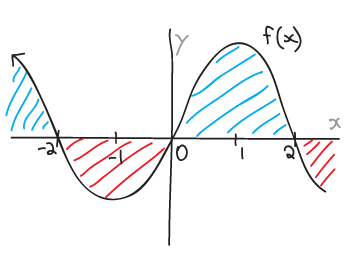
Determine the positive and negative intervals for the diagram of the function above.
Solution
Positive and negative intervals occur are based on where the function exists above or below the x-axis for positive or negative values of y.
Determine the intervals of increase and decrease for the diagram of the function above.
Solution
Think of the slope of the tangent at any one point. The intervals of increase have a tangent with a positive slope, and the intervals of decrease have a tangent with a negative slope.
Determine the where the function is concave up for the diagram of the function above.
Solution
The function is concave up on the intervals: -2 < x < 0, and x > 2
Absolute and Local Maximum and Minimum
Determine the correct statement.
Solution

The points are considered local when the function tends to infinity in the space.
Determine the correct statement.
Solution

The points are considered absolute (or global) when the 'y' value is the most extreme over the entire function.
Curve Sketching Theory
Complete the questions for the sketch of some, fictitious function below.
| f'(x) = 0 | f'(x) = D.N.E. | f'(x) = Undefined | notes: | |
| Critical Point | ✓ | ✓ | the most general term (also covers vertical POI) | |
| Stationary Point | ✓ | same or opposite slope on either side (more of a general term) | ||
| Turning Point | ✓ | opposite slope on either side | ||
| Horizontal Point of Inflection (POI) | ✓ | opposite concavity on either side, where f''(x) = 0 | ||
| Vertical Point of Inflection (POI) | ✓ | opposite concavity on either side, where f''(x) = undefined | ||
| Cusp or Corner | ✓ | different derivative (or limit) on either side: f'(x-) ≠ f'(x+) |

A Point of Inflection (POI) is where...
Solution
A Point of Inflection (POI) is defined as the point 'x' where the concavity changes, so where f''(x) changes sign [at f''(x) = 0].
Check all points that indicate a Point of Inflection (POI).
Solution
The concavity changes, and f''(x) = 0 at the points: I, III, V
What point on the graph is concave down with positive slope on the lefthand side, and is concave up with a positive slope on the righthand side.
Solution
Point: 'V'
Which of the following points are considered stationary points, or critical points, but not turning points, nor vertical points of inflection?
Solution
These points, located at 'III' and 'V', are sometimes referred to as saddle points:
- ✓✓ Stationary points either have opposite or same slopes on either side of f'(x) = 0
- ✓✓ Critical points have f'(x) = 0, or undefined
- ✗✗ Turning points have opposite slopes on either side of f'(x) = 0
- ✗✗ Points of inflection have opposite concavity on either side of f''(x) = 0
Given the diagram, the classifications of each point is:
- ✓✓ Stationary points either have opposite or same slopes on either side of f'(x) = 0
- ✓✓ Critical points have f'(x) = 0, or undefined
- ✗✗ Turning points have opposite slopes on either side of f'(x) = 0
- ✗✗ Points of inflection have opposite concavity on either side of f''(x) = 0
Which point is a corner?
Solution
At a corner (like a cusp):
f'(x) Does Not Exist (DNE) because the derivative (or limit, or slope) from the left side of 'x' does not equal the derivative (or limit, or slope) from the right side of 'x'.
Which point is a cusp?
Solution
At a cusp (like a corner):
f'(x) Does Not Exist (DNE) because the derivative (or limit, or slope) from the left side of 'x' does not equal the derivative (or limit, or slope) from the right side of 'x'.
Point 'II' could be characterized as which three of the following?
Solution
- Critical point
- Turning point
- Stationary point
- Critical point
- Turning point
- Stationary point
Which of the following points does the table represent? Solution
| f(x) | f'(x) | f''(x) | |
| x- | + | — | — |
| x | 0 | — | 0 |
| x+ | — | — | + |
It represents point 'III' where f'(x) = 0 and the slope is the same (negative) on both sides of 'x'
- f(x) tells what side of the x-axis
- f'(x) indicates whether slope is positive or negative
- f''(x) indicates whether concave up or concave down
Curve Sketching Theory: Derivatives and Slope
Solve each theory question below.
If a point is substituted into the original function ƒ(x), where ƒ(x) < 0, what does this mean about the function at this point?
Solution
This means the function is negative at this point (below the x-axis).
ƒ(x) > 0 →→→ POSITIVE
ƒ(x) < 0 →→→ NEGATIVE
ƒ(x) > 0 →→→ POSITIVE
ƒ(x) < 0 →→→ NEGATIVE
If ƒ'(x) < 0, then ƒ(x) is increasing.
Solution
If ƒ'(x) < 0, then the slope is negative, so the function is decreasing.
The function is increasing where ƒ'(x) > 0
The function is decreasing where ƒ'(x) < 0
The function is increasing where ƒ'(x) > 0
The function is decreasing where ƒ'(x) < 0
The slope of a tangent is positive if
Solution
The slope is positive if the derivative is positive (greater than zero) so the answer is c.
Explain how to determine the vertical asymptote (VA) and horizontal asymptote (HA) for a rational function (where applicable, if there are any asymptotes).
Solution
A vertical asymptote (VA) occurs for all values of 'x' that make the denominator equal to zero.
If the degree of the denominator is greater than the degree of the numerator: The horizontal asymptote (HA) equals the 'vertical translation constant,' 'd'.
If the degree of the denominator is equal to the degree of the numerator: The horizontal asymptote (HA) is found by setting the coefficients of the leading (highest) degrees of 'x' in the numerator and denominator into a fraction, and adding the 'vertical translation constant,' 'd'.
If the degree of the denominator is greater than the degree of the numerator: The horizontal asymptote (HA) equals the 'vertical translation constant,' 'd'.
If the degree of the denominator is equal to the degree of the numerator: The horizontal asymptote (HA) is found by setting the coefficients of the leading (highest) degrees of 'x' in the numerator and denominator into a fraction, and adding the 'vertical translation constant,' 'd'.
How is a critical point (aka stationary point, turning point, or point of inflection) found?
Solution
Setting the first derivative ƒ'(x) equal to zero and solving for 'x'
Substituting an x-value into the second derivative ƒ''(x) gives us a positive y-value result. Also, f'(x) = 0. What can be concluded from this?
Solution
Since we alreay know that a max or min occurs, beause f'(x) = 0. The second derivative ƒ''(x) confirms if the point is a Maximum, Minimum, or Neither.
ƒ''(x) > 0 →→→ Concave Up →→→ MIN
ƒ''(x) < 0 →→→ Concave Down →→→ MAX
ƒ''(x) = 0 →→→ NEITHER/INCONCLUSIVE
ƒ''(x) > 0 →→→ Concave Up →→→ MIN
ƒ''(x) < 0 →→→ Concave Down →→→ MAX
ƒ''(x) = 0 →→→ NEITHER/INCONCLUSIVE
Which of the following test outcomes is used to confirm the presence of either a cusp or a corner, at 'x'?
Solution
Corners and cusps exist where f'(x-) ≠ f'(x+)
Stationary/Critical Points (Turning Points)
For the function,
Determine the x-coordinates of the stationary points.
Solution
Video
To determine stationary/critical points: set derivative, ƒ’(x) equal to zero and solve for x...
Determine the nature of the stationary/critical points.
Solution
Video
Differentiate:
We must determine if the stationary/critical points are maximum, minimum, or neither by substituting x into second derivative, ƒ’’(x).
The following is positive, ƒ''(x) > 0 and since f'(x) = 0, therefore this point is a local MINIMUM:
The following is negative, ƒ''(x) < 0 and since f'(x) = 0, therefore this point is a local MAXIMUM:
Stationary/Critical Points
Determine the coordinates of the stationary/critical points of the function below and determine their nature.
Solution
Video
Stationary/critical points (turning points or points of inflection) are determined by setting ƒ'(x) = 0...
Coordinates: (-5,0), (1, 1296), (7,0).
[These points are are max/min because we already showed that f'(x) = 0]
Characterizing Points of Inflection
You know there is a point of inflection (POI) at 'x' because it has opposite concavity on either side of 'x', and the same sign (positive/negative) of slope on either side of 'x'. Given the following characteristics, classify the POI.
Solution
f'(x) ≠ 0, and f'(x) defined
For each:
- Horizontal POI: f'(x) = 0
- Vertical POI: f'(x) = undefined
- Oblique POI: f'(x) ≠ 0
- Horizontal POI: f'(x) = 0
- Vertical POI: f'(x) = undefined
- Oblique POI: f'(x) ≠ 0
Stationary/Critical Points: Horizontal Point of Inflection
For the function...
Determine the positive and negative intervals.
Solution
Video
Positive interval: ƒ(x) is positive
Negative interval: ƒ(x) is negative
Substitute all points on either side of all points of inflection into ƒ'(x)...
For x < 0
Since ƒ(x) is negative, the interval x < 0 is negative.
For x > 0
Since ƒ(x) is positive, the interval x > 0 is positive.
Negative interval: ƒ(x) is negative
Substitute all points on either side of all points of inflection into ƒ'(x)...
For x < 0 Since ƒ(x) is negative, the interval x < 0 is negative.
For x > 0 Since ƒ(x) is positive, the interval x > 0 is positive.
Find the point of inflection for the function.
Solution
Video
Points of inflection occur where ƒ'(x) = 0...
Try to factor 5x2 - 12x + 15...
Using the discriminant (b2 - 4ac), we can find that there are no real solutions to the equation 5x2 - 12x + 15.
∴ (0,0) is the only point of inflection.
Using the discriminant (b2 - 4ac), we can find that there are no real solutions to the equation 5x2 - 12x + 15.
∴ (0,0) is the only point of inflection.
Determine the intervals of increase and decrease.
Solution
Video
Intervals of increase: ƒ'(x) is positive
Intervals of decrease: ƒ'(x) is negative
Substitute all points on either side of all points of inflection into ƒ'(x)...
For x < 0
For x > 0
∴ The function is increasing everywhere, since ƒ'(x) is positive on all intervals.
Intervals of decrease: ƒ'(x) is negative Substitute all points on either side of all points of inflection into ƒ'(x)...
For x < 0 For x > 0 ∴ The function is increasing everywhere, since ƒ'(x) is positive on all intervals.
Classify the point of inflection. Show your calculations.
Solution
Video
This means determine if the stationary/critical point is a local maximum, local minimum, or neither (point of inflection).
To classify a point of inflection, substitute the turning point x-value into the second derivative function ƒ''(x).
Check the sign. Positive = concave up (local MINIMUM), negative = concave down (local MAXIMUM), zero = Neither/Inconclusive.
∴ This point of inflection is neither a local maximum, nor a local minimum. It is a horizontal point of inflection.
Check the sign. Positive = concave up (local MINIMUM), negative = concave down (local MAXIMUM), zero = Neither/Inconclusive. ∴ This point of inflection is neither a local maximum, nor a local minimum. It is a horizontal point of inflection.
Graphing the Reciprocals of Linear Functions
For the reciprocal of the function , determine:
The vertical and horizontal asymptotes, and the domain and range.
Solution
Video
The positive/negative intervals.
Solution
Video
To find positive/negative intervals substitute x-values on either sides of the vertical asymptotes into ƒ(x), and check if function is positive or negative...
Since the vertical asymptote is x=5/4, check the intervals: x<5/4, and x>5/4...
For x < 5/4...
ƒ(x) is negative, ∴ the function is negative where x < 5/4.
For x > 5/4...
ƒ(x) is positive, ∴ the function is positive where x > 5/4.
Since the vertical asymptote is x=5/4, check the intervals: x<5/4, and x>5/4...
For x < 5/4... ƒ(x) is negative, ∴ the function is negative where x < 5/4.
For x > 5/4... ƒ(x) is positive, ∴ the function is positive where x > 5/4.
The increasing/decreasing intervals.
Solution
Video
To determine the increasing/decreasing intervals substitute x-values on either sides of any turning points and vertical asymptotes into ƒ'(x), and check if positive or negative...
Since there are no turning points in this particular rational function, use the vertical asymptote, x = 5/4...
Check the intervals in the derivative ƒ'(x): x<5/4, and x>5/4...
For x<5/4...
Since the derivative (slope) is negative, ∴ the function is decreasing for x<5/4.
For x>5/4...
Since the derivative (slope) is negative, ∴ the function is decreasing for x>5/4.
Since there are no turning points in this particular rational function, use the vertical asymptote, x = 5/4... Check the intervals in the derivative ƒ'(x): x<5/4, and x>5/4...
For x<5/4... Since the derivative (slope) is negative, ∴ the function is decreasing for x<5/4.
For x>5/4... Since the derivative (slope) is negative, ∴ the function is decreasing for x>5/4.
Graphing the Reciprocals of Quadratic Functions
For the reciprocal of the function , determine:
The vertical and horizontal asymptotes, and the domain and range.
Solution
Video
Determine where a stationary/critical (turning) point exists.
Solution
The turning point exists between the vertical asymptotes, -4 and -3/2...
The positive/negative intervals.
Solution
Positive interval: ƒ(x) is positive
Negative interval: ƒ(x) is negative
Substitute all points on either sides of any stationary/critical points (turing points) or vertical asymptotes into ƒ'(x)...
For x < -4...
∴ the function is positive on the interval x < -4.
For -4 < x < -3/2...
∴ the function is negative on the interval -4 < x < -11/4.
For x > -3/2...
∴ the function is positive on the interval x > -3/2.
Negative interval: ƒ(x) is negative
Substitute all points on either sides of any stationary/critical points (turing points) or vertical asymptotes into ƒ'(x)...
For x < -4... ∴ the function is positive on the interval x < -4.
For -4 < x < -3/2... ∴ the function is negative on the interval -4 < x < -11/4.
For x > -3/2... ∴ the function is positive on the interval x > -3/2.
The increasing/decreasing intervals.
Intervals of increase: ƒ'(x) is positive
Intervals of decrease: ƒ'(x) is negative
First calculate the derivative:
Substitute all points on either sides of any points of inflection (turing points) or vertical asymptotes into ƒ'(x)...
For x < -4...
∴ the function is increasing on the interval x < -4.
For -4 < x < -11/4...
∴ the function is increasing on the interval -4 < x < -11/4.
For -11/4 < x < -3/2...
∴ the function is decreasing on the interval -11/4 < x < -3/2.
For x > -3/2...
∴ the function is decreasing on the interval x > -3/2.
Intervals of decrease: ƒ'(x) is negative
First calculate the derivative: Substitute all points on either sides of any points of inflection (turing points) or vertical asymptotes into ƒ'(x)...
For x < -4... ∴ the function is increasing on the interval x < -4.
For -4 < x < -11/4... ∴ the function is increasing on the interval -4 < x < -11/4.
For -11/4 < x < -3/2... ∴ the function is decreasing on the interval -11/4 < x < -3/2.
For x > -3/2... ∴ the function is decreasing on the interval x > -3/2.
Vertical Asymptote
The function has at least one, real vertical asymptote.
Solution
False, there are no vertical asymptotes because the vertical asymptote is the value of 'x' that makes the denominator equal to zero.
Asymptotes (using Limits)
Find the vertical asymptote of the function below..
Solution
The vertical asymptote is the value of x that makes the denominator equal to zero.
Therefore there is a vertical asymptote on the line x = 4.
Find the vertical asymptotes and holes of the function below.
Solution
The vertical asymptote is found from the value of x that makes the denominator equal to zero:
Holes are the found from the value of x in the terms that cancel, in this case (x+1):
(Restrictions are still x ≠ 1, -1)
Use limits to find the horizontal asymptote.
Solution
One must divide every term by the highest power of x:
Asymptotes (using Limits)
For the function.
Find the vertical asymptotes.
Solution
The vertical asymptote is found from the value of x that makes the denominator equal to zero:
Find the oblique asymptote.
Solution
The oblique asymptote is the quotient (what you get from division). So, using polynomial division:
Now one must take the limit
Therefore the oblique asymptote exists on the line: y = x - 1.
Sketch ƒ(x).
Solution
Does not have to be to scale, remember that it is a sketch.
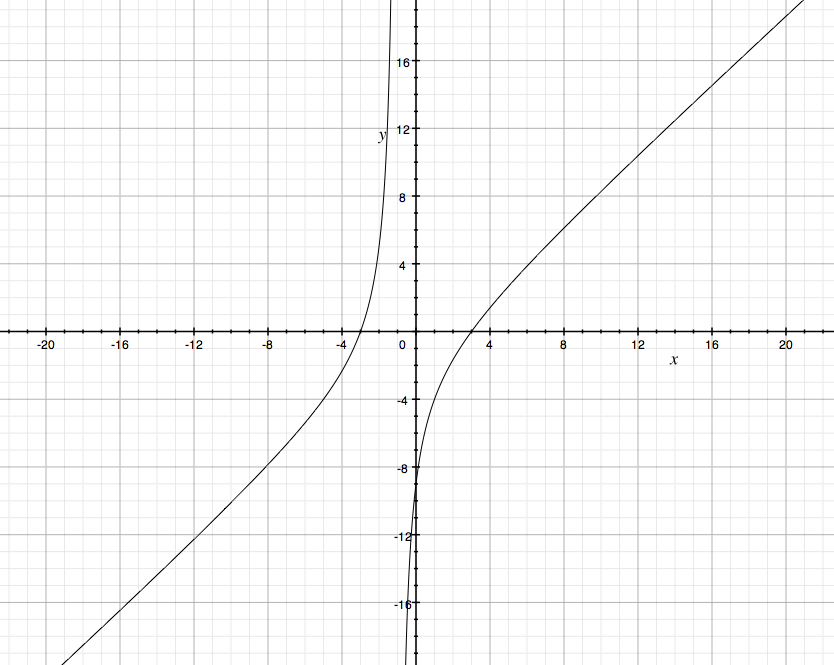

Asymptotes (using Limits)
For the function:
Find all asymptotes.
Solution
Vertical asymptote is found from the value of x that makes the denominator equal to zero:
Since the degree of the numerator is the same as the degree of the denominator, there is a horizontal asymptote. Start by dividing everything by the highest power of x leaving:
Sketch.
Solution
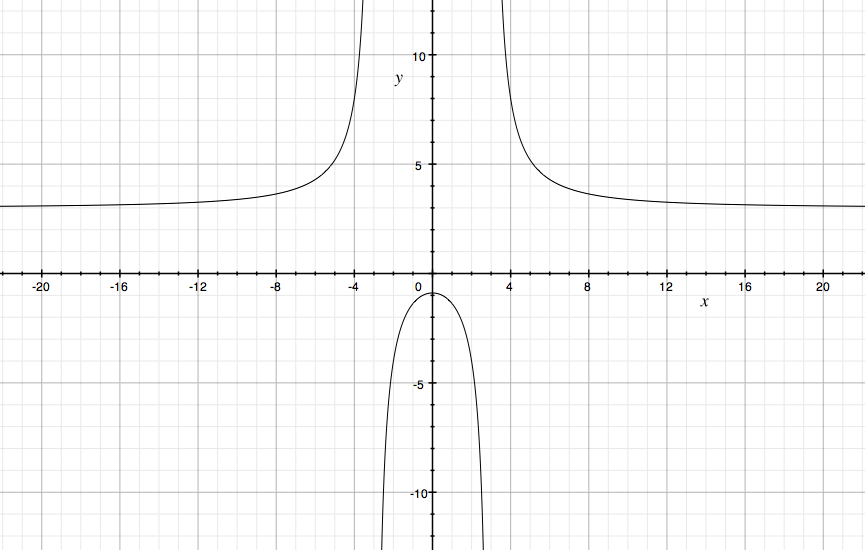

Sketching in Full: Intercepts, Asymptotes, Local Max/Min, and Intervals
Determine each of the properties for the function:
The 'x' and 'y' intercepts.
Solution
y-intercept:
x-intercept:
The vertical and horizontal asymptotes.
Solution
The vertical asymptote is found from the value of x that makes the denominator equal to zero:
The function has a horizontal asymptote because the degree of the numerator is less than the degree of the denominator. Use limits to find the horizontal asymptote:
The equations of the asymptotes are:
- Vertical asymptote: x = -2, +2
- Horizontal asymptote: x = 0
- Vertical asymptote: x = -2, +2
- Horizontal asymptote: x = 0
The local maximum and/or minimum.
Solution
Use the first derivative to find critical point(s). Use the quotient rule for the derivative
Remember, the critical point occurs where the slope, f’(x) equals zero:
This is not factorable, so using the quadratic formula:
Do a second derivative test to ensure the point(s) are local max/min, rather than just saddle points. Remember, where 'c' is a stationary point, it's a concave up (local minimum) where f''(c) > 0, and a concave down (local maximum) where f''(c) < 0.
So at the two points,
[Just plug the 'x' into the original, f(x) to determine the corresponding 'y' values...]
The positive/negative intervals.
Solution
Make a table with the x-intercepts, vertical asymptotes, and any local max/min. Determine the signs on the original function:
So the intervals would be:
-∞ to -7.46 -7.46 to -4 -4 to -2 -2 to -0.54 -0.54 to 2 2 to +∞
x + 4 — — + + + +
x2 - 4 + + + — — +
Result of f(x) — — + — — +
So the function has negative intervals (exists below the x-axis, where f(x) < 0) for:
{x < -4, -2 < x < 2}
So the function has positive intervals (exists above the x-axis, where f(x) < 0) for:
{-4 < x < -2, x > 2}
| -∞ to -7.46 | -7.46 to -4 | -4 to -2 | -2 to -0.54 | -0.54 to 2 | 2 to +∞ | |
| x + 4 | — | — | + | + | + | + |
| x2 - 4 | + | + | + | — | — | + |
| Result of f(x) | — | — | + | — | — | + |
The intervals of increase/decrease.
Solution
Make a table with the x-intercepts, vertical asymptotes, and any local max/min. Determine the signs on the first derivative:
So the intervals would be:
-∞ to -7.46 -7.46 to -4 -4 to -2 -2 to -0.54 -0.54 to 2 2 to +∞
-x2 - 8x - 4 — + + + — —
(x2 - 4)2 + + + + + +
Result of f'(x) — + + + — —
So the function has intervals of increase (positive slope where f'(x) > 0) for:
{-7.45 < x < -0.54}
So the function has intervals of decrease (negative slope where f'(x) < 0) for:
{-7.45 > x > -0.54}
| -∞ to -7.46 | -7.46 to -4 | -4 to -2 | -2 to -0.54 | -0.54 to 2 | 2 to +∞ | |
| -x2 - 8x - 4 | — | + | + | + | — | — |
| (x2 - 4)2 | + | + | + | + | + | + |
| Result of f'(x) | — | + | + | + | — | — |
Sketching with Roots and Critical Points
Critical turning points of ƒ(x) usually become roots of ƒ'(x).
Solution
Mostly true... The derivative, ƒ'(x) is the slope of the original function. At ƒ'(x) = 0, the slope of ƒ(x) is zero, so therefore the graph must be “stationary” at 'x'.
The exceptions are corners and cusps, where the derivative, ƒ'(x) Does Not Exist (DNE), because the limit from the left does not equal the limit from the right.
The exceptions are corners and cusps, where the derivative, ƒ'(x) Does Not Exist (DNE), because the limit from the left does not equal the limit from the right.
Determine the critical point(s).
Solution
Determine the critical point by setting ƒ’(x) equal to zero, and solving for x. This is where the slope of the tangent is equal to zero.
Sub x into ƒ’(x) to get y:
The critical point is
Since ƒ''(x) > 0, therefore this point is a minimum.
Sketch ƒ(x) using the information from part 'a'.
Solution
This uses the stationary/critical point (vertex) found using the derivative ƒ'(x):
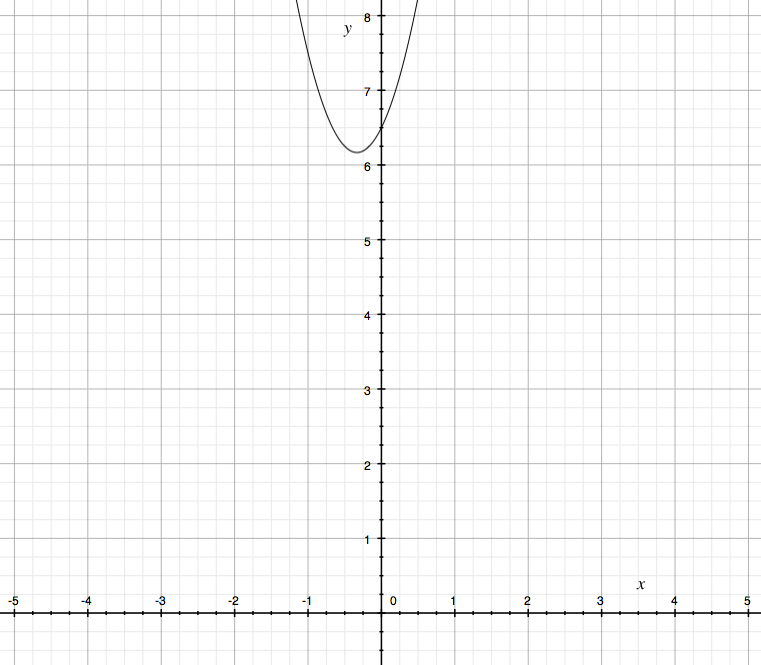

Graphing the Derivative
Given the graph of ƒ(x) below, make a rough sketch graph of ƒ'(x).
Solution
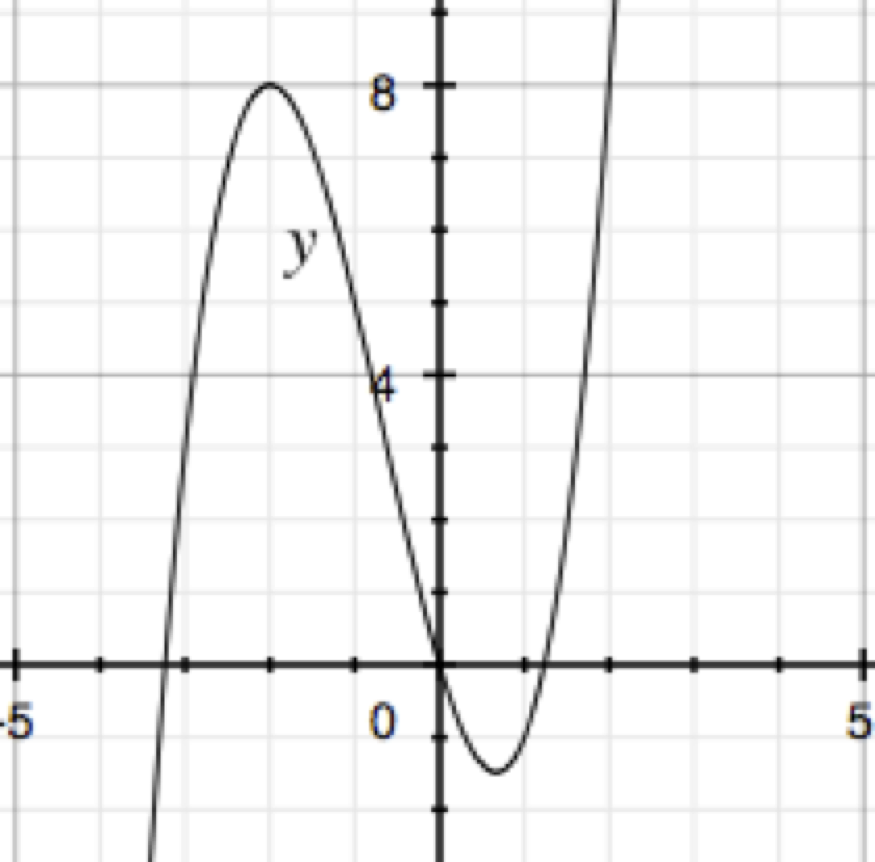 The graph of the derivative, ƒ'(x) is the slope of the points along the function ƒ(x). Stationary/critical points become roots. The graph must be analyzed to see if the slope is increasing or decreasing
The graph of the derivative, ƒ'(x) is the slope of the points along the function ƒ(x). Stationary/critical points become roots. The graph must be analyzed to see if the slope is increasing or decreasing
Just make a rough sketch:
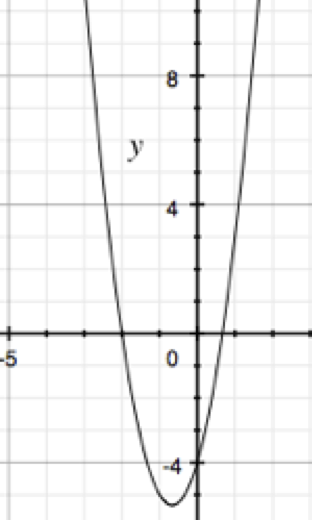
Just make a rough sketch:

Given ƒ'(x), make a rough sketch a graph of ƒ(x).
Solution
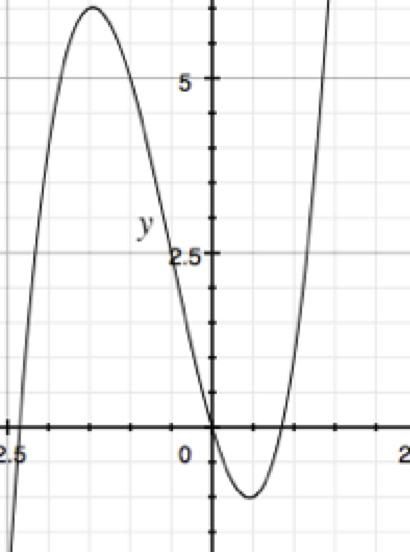 There are more possibilities for this curve as there could be any “c” value that translates the graph up or down. Roots become stationary/critical points and stationary/critical points become points of inflection.
There are more possibilities for this curve as there could be any “c” value that translates the graph up or down. Roots become stationary/critical points and stationary/critical points become points of inflection.
Just make a rough sketch:
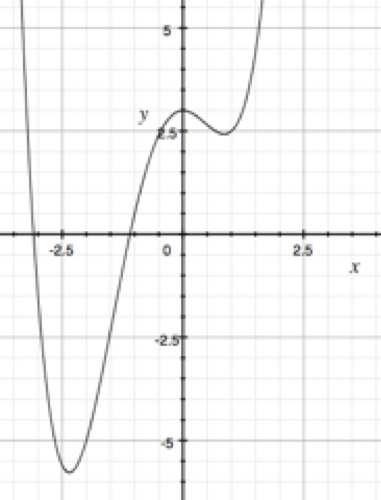
Just make a rough sketch:

Given the sketch of ƒ(x) below, sketch .
Solution
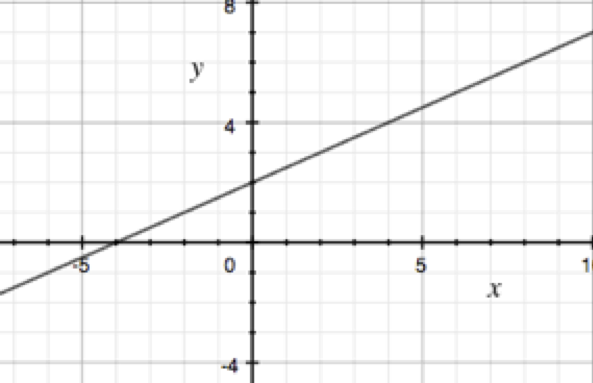 Roots become asymptotes.
Roots become asymptotes.
Just make a rough sketch:
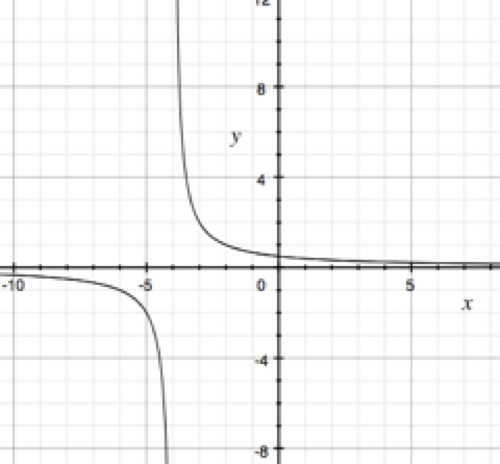
Just make a rough sketch:

Curve Sketching Given the Graphs
Given the sketch of g(x) below, sketch .
Solution
 Roots become asymptotes and maxima becomes minima.
Roots become asymptotes and maxima becomes minima.
Just make a rough sketch:
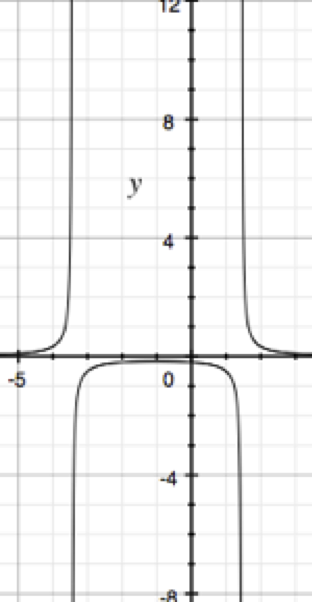
Just make a rough sketch:

Given the sketch of ƒ(x) below, sketch .
Solution
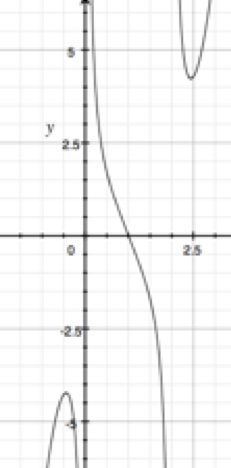 Asymptotes become roots, roots become asymptotes, and maxima becomes minima.
Asymptotes become roots, roots become asymptotes, and maxima becomes minima.
Just make a rough sketch:
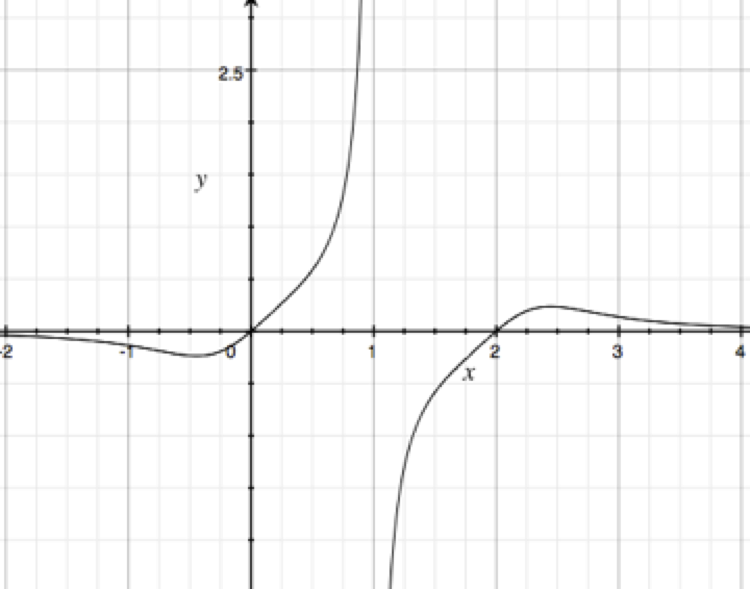
Just make a rough sketch:

Equations of Tangents to Curves
Determine the equation of the tangent (in slope-y-intercept form) to the curve below, at the point, t = 1/2.
Solution
y =
Hint
Clear
Info
Incorrect Attempts:
CHECK
Hint Unavailable
Remember, the derivative is the equation of the slope.
At the point t = 1/2, the slope is..
And determine the y-intercept of the linear system using the coordinate at the point t = 1/2
Now that you have the slope (m = 96) and the coordinate (1/2, 64).. solve for the equation,
So the equation, in slope-y-intercept form, is:
y =
Hint
Clear
Info
Incorrect Attempts:
CHECK
Hint Unavailable
Equations of Tangents to Curves II
Determine the two equations of the tangents (in slope-y-intercept form) to the curve below, if both tangents cross at a point not on the curve: A(1, -20).
Solution
y =
Hint
Clear
Info
Incorrect Attempts:
CHECK
Slope is the derivative.. there are two ways to calculate slope.. finally, enter your final answers as equations in y-intercept form
The derivative gives the equation of the slope, m,
Make up a point where the tangent intercepts the curve: B(x, f(x)), then plug that into the slope equation with the point A(1, -20)..
Then set this equal to the slope equation from before, m = 2x + 8
Now find 'y' using the original f(x), to give you the coordinates of the tangent points!
Now determine the slope,
Now determine the equation of the tangent lines, and you're done!
y =
Hint
Clear
Info
Incorrect Attempts:
CHECK
Slope is the derivative.. there are two ways to calculate slope.. finally, enter your final answers as equations in y-intercept form
Now determine the slope,
Now determine the equation of the tangent lines, and you're done!
Equations of Tangents to Curves III
Determine the area between the y-axis, x-axis, and tangent (line) to the function f(x). Given the tangent passes through the x-axis at (6.75, 0) and passes through the function somewhere, where x < 6...
Solution
Hint
Clear
Info
Incorrect Attempts:
CHECK
units2
Hint Unavailable
Determine the slope 'm' of the function f(x)
Make a point on f(x) that the tangent passes through: A[a, f(a)]. Then, using this and (6.75, 0)...
Set the two equations for slope equal, to solve for 'a'
We found 'a'! So now,
So the point on the function is (5, 7). Now determine the slope 'm',
Now determine the y-intercept of the tangent line using the point (5, 7) and the slope 'm' = -4
Now calculate the area of the triangle, using the y-intercept as height, and the x-intercept as the base (which was given in the question).
Hint
Clear
Info
Incorrect Attempts:
CHECK
units2
Hint Unavailable
Stationary/Critical Point Application: Solving for Constants
The following function has a local minimum at (1, -90) and an oblique point of inflection at (-2, 180). Determine the values of the constants: 'A' 'B' 'C' and 'D'.
Solution
Hint
Clear
Info
A = B = C = D =
Incorrect Attempts:
CHECK
Hint Unavailable
Given the point on the curve, (1, -90)
Given the point on the curve, (-2, 180)
The local minimum (1, -90) occurs where f'(x) = 0,
The oblique point of inflection has opposite concavity on either side. Do a second derivative test at the inflection point. Concave up where f''(c) > 0, and concave down where f''(c) < 0, so test in the middle where f''(c) = 0
You can now solve for 'A' 'B' 'C' and 'D', the following shows this... First, sub Equation 4 into Equation 3
Set Equation 1 equal to Equation 2, and substitute your newfound values of 'B' and 'C'...
And then,
And then,
And then,
Hint
Clear
Info
A = B = C = D =
Incorrect Attempts:
CHECK
Hint Unavailable
The following function has the coordinate (-1, 39) and, the derivative has critical points located at x = -4, -1, 5. Determine the values of the constants: 'A' 'B' and 'C'.
Solution
Hint
Clear
Info
A = B = C =
Incorrect Attempts:
CHECK
Hint Unavailable
Differentiate,
Critical points occur where the derivative equals zero, using x = -4,
Using x = -1,
Using x = 5,
Use the coordinate (-1, 39) on f(x),
Solve the system of equations: using equation 2 & 3
Solve the system of equations: using equation 1 & 4
Substitute equation 5 & 6,
Sub this into equation 5
Sub these both into equation 4
Hint
Clear
Info
A = B = C =
Incorrect Attempts:
CHECK
Hint Unavailable
Derivatives (Trig, Implicit, Log, Exp) & Related Rates
Aside: Trig Notation
tan3(x) = [tan(x)]3
Solution
tan3(x) = tan(x)tan(x)tan(x) = [tan(x)]3
sin2(x) = sin(x2)
Solution
Video
sin2(x) = sin(x)sin(x) = [sin(x)]2
sin-1(x) = [sin(x)]-1
Solution
False. sin-1(x) equals the angle, while [sin(x)]-1 equals the reciprocal of the ratio...
Trigonometric Derivatives with Other Parameters
Differentiate.
sin(100x)
Solution
y = 2cos(4x3)
Solution
y = sin(3x2 - 2x + 7)
Solution
Solution
Video
Solution
This can actually be simplified using the quotient identity...
Trigonometric Derivatives: Chain Rule
If ƒ(x) = csc(x), then ƒ'(x) = csc(x)·cot(x)
Solution
Differentiate: sec3(x)
Solution
Differentiate: sin3(5x)
Solution
Differentiate:
Solution
This can actually be simplified further using the reciprocal quotient identity...
Given: , then
Solution
Be careful, this question confuses some people, so make sure to do it like this (chain rule)...
Trigonometric Derivatives: Quotient Rule
Evaluate.
Solution
Differentiate
Solution
Using the quotient rule...
u = x2 + x
v = sin(x)
v = sin(x)
Differentiate, using the quotient rule to prove the derivative. Show your work.
Solution
Use the identity:
Using trig derivatives, and the quotient rule... Here is the proof! ...
And so of course, on your formula sheet you see:
Trigonometric Derivatives
Given:
Determine ƒ'(x).
Solution
Determine g'(x).
Solution
Determine
Solution
Determine
Solution
Given the trig functions above, determine whether the left side equals the right side, with the following:
Solution
As determined above, both sides are equal,
Trigonometric Derivatives
Given the following information.
Find the derivative of ƒ(x) = sin(x) from first principles.
Solution
Find the derivative of ƒ(x) = cos(x) from first principles.
Solution
Trigonometric Derivatives with Double Angle
Differentiate. Simplify your answer in terms of the 'double angles' [Hint: as a general rule, apply the double angle formula first, before differentiation.]
Solution
[There are several paths to reach the final answer. This is one.] Common factor,
Apply the double angle formula.
Differentiate, using product rule u'v + uv'...
And simplify, back into 'double angle' terms, and recognize the 'difference of squares'...
Implicit Differentiation
Differentiate using implicit differentiation, to find .
Solution
Determine the line where the mistake first appears.
Solution
It should be,
Only write when differentiation on the 'y'...
Solution
Use the chain rule, and the product rule...
Solution
Implicit Differentiation - Second Derivative
Use implicit differentiation.
Determine .
Solution
Determine . Simplify fully, with your answer in terms of 'x'.
Solution
Previously you determined,
Differentiate, using quotient rule,
Now substitute ,
Remember the question stated that , so substituing this...
Implicit Differentiation with Different Types
Differentiate using implicit differentiation. Show your work [in your notes]. Brush up on the different differentiation types first, then you will be ready for this.
Solution
This question contains exponential and logarithmic differentiation types.
Isolate, and simplify a little bit,
Implicit Differentiation with Inverse Trig Functions
Differentiate using implicit differentiation. Show your work.
Solution
First, see the following,
Then differentiate,
Theory of Exponential and Logarithmic Derivatives with Implicit Differentiation
Practice the theory of the following derivatives, using implicit differentiation. 'a' represents a constant.
Find given the following information. This question derives the derivative of an exponential function, using the derivative of the natural log...
Solution
Take the derivative, with respect to 'x', and remember that 'a' is a constant,
Now isolate for
Recall that
Find , given the information below.
Solution
Taking the ln of both sides. Then, differentiate implicitly, with respect to 'x'. Use product rule on the left-hand side.
Natural Exponential Derivatives
Determine ƒ''(x) given the function below.
Solution
Remember the rule:
Then,
Natural Exponential Derivatives - Different Types
Differentiate each of the following.
Solution
Solution
Solution
With chain rule,
Solution
With product rule,
Solution
Use produce rule twice,
Solution
Simplify first,
Then differentiate, and simplify further,
Solution
Logarithmic Derivatives
Differentiate.
Solution
ƒ(x) = 2x4·ln(3x-1)
Solution
Use the Product Rule: ƒ'(x) = u'v + uv'
u = 2x4
v = ln(3x-1)
u = 2x4
v = ln(3x-1)
Logarithmic Derivatives
Remember the log laws to use when differentiating the questions below.
y = ln[(3x - 1)3]
Solution
y = ln(3x2 e2x)
Solution
4ln(ln(3x)2)
Solution
Solution
Apply log laws...
Logarithmic Derivatives
Differentiate
Solution
Take the ln of both sides
Logarithmic Derivatives
Use the rules of logarithms to find the derivative of ln(x) through differentiation from first principles.
Solution
Recall that
Recall that
By factoring out an x and then using the previous property, the expression becomes
Use the result of the derivative of ln(x) through first principles to find the following.
Solution
Taking the derivative with respect to x...
Exponential and Logarithmic Derivatives
Which of the following are true?
Solution
- If
- If
- If
I) correct:
II) incorrect:
III) correct:
- If
- If
- If
Differentiate
Solution
Since 'x' is in both the base and the exponent, one must take the ln of both sides
Derivatives Combining: Trig, Exponential, and Logarithmic
Differentiate.
Solution
Solution
⁰
¹
²
³
⁴
⁵
⁶
⁷
⁸
⁹
⁻
⁺
⁽
⁾
₀
₁
₂
₃
₄
₅
₆
₇
₈
₉
₋
₊
₍
₎
Incorrect Attempts:
CHECK
Hint Unavailable
⁰
¹
²
³
⁴
⁵
⁶
⁷
⁸
⁹
⁻
⁺
⁽
⁾
₀
₁
₂
₃
₄
₅
₆
₇
₈
₉
₋
₊
₍
₎
Incorrect Attempts:
CHECK
Hint Unavailable
Solution
Simplify,
Then differentiate, using product rule, like u'v + uv'...
Random
The derivative of ax equals
Solution
The general derivative of an exponential function is:
ax·ln(a)
For example:
State whether the following is true or false.
Solution
The derivative of the sine function is:
sin'(a) = cos(a)
But cos'(a) = -sin(a)
But cos'(a) = -sin(a)
State whether the following is true or false.
Solution
Video
This is the derivative of the inverse cosine function, and we need to denationalize the denominator. This may be a bit tricky as a question, but we don't leave roots in the denominator.
The derivative of tan(x) equals
Solution
Video
The derivative of the tan function is:
tan'(x) = sec2(x)
Differentiate.
Solution
Differentiate.
Solution
Differentiate,
And simplify,
Curve Sketching Exponential & Logarithmic
For the function...
Solve for 'x' of the critical point.
Solution
Hint
Clear
Info
━━
Incorrect Attempts:
CHECK
Hint Unavailable
Differentiate,
Set equal to zero
Hint
Clear
Info
━━
Incorrect Attempts:
CHECK
Hint Unavailable
Determine the coordinates of the function, where the slope of the tangent line is . Round your answer to the nearest tenth decimal.
Solution
Hint
Clear
Info
( , )
Incorrect Attempts:
CHECK
Hint Unavailable
Previously, you determined the equation of the tangent, from the derivative...
The 'y' value...
Hint
Clear
Info
( , )
Incorrect Attempts:
CHECK
Hint Unavailable
Curve Sketching Exponential & Logarithmic
For the function:
Differentiate.
Solution
Use the quotient rule:
Find the root(s), (graphing calculator allowed).
Solution
Use graphing calculator
Root: (1.24, 0)
Find the stationary/critical point(s) and determine the nature (graphing calculator allowed).
Solution
Use graphing calculator
Stationary/critical point: (0.213,-0.812)
Therefore it is a minimum
Sketch ƒ(x).
Solution
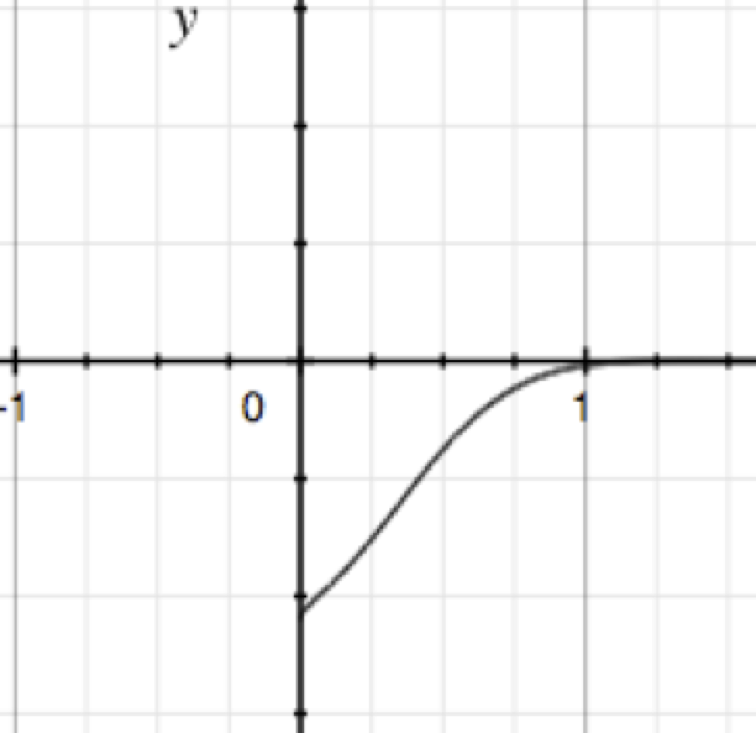

Curve Sketching Exponential & Logarithmic
Given:
Find the coordinates of the stationary/critical point(s).
Solution
The stationary/critical point occurs where the derivative, ƒ’(x) is equal to zero:
Stationary/critical point:
Determine what type of stationary/critical point it or they are.
Solution
Determine the nature of the second derivative, ƒ’’(x)
Since any power of 'e' must be greater than zero.
Therefore, is a minimum
Therefore, is a minimum
Curve Sketching Exponential & Logarithmic
On what intervals is the function increasing?
Solution
ƒ(x) is increasing when ƒ'(x) > 0
For x∈ℝ, the sign on ƒ'(x) is dependent on the sign of
Since the output will be positive for every even degree of x, for all x∈ℝ, and therefore ƒ(x) > 0 for all x∈ℝ.
Motion: Logarithmic Derivative Application
A particle moves in a straight line such that its displacement, “s,” in a time “t” can be modeled by the following function:
Find an expression in terms of time for its velocity, “v”.
Solution
Find an expression in terms of time for its acceleration, “a”.
Solution
Induced electromagnetic waves oppose the motion of the particle by providing an oscillating resistive force in Newtons, “N,” on it. At t = 2 seconds, velocity is constant. Given that in a simple system such as this, force is the product of mass and acceleration, and the mass is equal to 10 × 10-30 kg, find the resistive force applied such that the velocity of the particle will be constant.
Solution
For velocity to be constant, the acceleration must be equal to zero, and therefore the force due to the oscillating waves must be equal to the applied force on the particle.
Let force be “F” and mass be “m”
The force of the induced electromagnetic waves is equal to the force on the particle, so therefore the force is equal to 7.57 × 10-29 N.
Let force be “F” and mass be “m” The force of the induced electromagnetic waves is equal to the force on the particle, so therefore the force is equal to 7.57 × 10-29 N.
Related Rates
Related Rates Intro
Choose the best answer for each.
Someone can type 40 words per minute. Represent this as a rate, with respect to time.
Solution
For related rates, the best representation is
A puddle is evaporating 'e', losing water at a rate of 200 mL/hour. Represent this as a rate, with respect to time.
Solution
For related rates, the best representation is a negative rate,
Differentiate the equation for circumference of a circle, 'with respect to time, t'.
Solution
The rate of C is properly shown as,
And the radius change with respect to time, 't' should be shown as,
An average reader can read 'r' twice as fast as a typist can type 'T'. Represent this with with respect to time.
Solution
Using proper notation, showing the rate 'with respect to time, t',
E.g.) Read at 180 words/min, and type at 90 words/min [accurate numbers]...
Differentiating the following, with respect to time, will result in what degree of derivatives, respectively?
Solution
Differentiating a linear function, results in a constant, zeroth degree (d0) derivative:
Differentiating a quadratic function, results in a first (r1) degree derivative:
Differentiating a cubic function, results in a second degree derivative:
Related Rates: Geometry
Solve the related rate problems.
A drop of dish soap is added to water with pepper floating on the surface. The surface tension is broken and a circle is cleared away from the pepper. If the total diameter of the surface of the liquid is 14 cm, and the area increases at a constant rate, 25π cm/s, then how fast is the radius of the cleared space increasing when the area of the cleared space is 9π cm2?
Solution
 Hint
Clear
Info
Incorrect Attempts:
CHECK
cm/s2
Hint Unavailable
Given the rate,
When the area is 9π cm2,
Differentiate for area 'A' with respect to time,
Hint
Clear
Info
Incorrect Attempts:
CHECK
cm/s2
Hint Unavailable
Given the rate,
When the area is 9π cm2,
Differentiate for area 'A' with respect to time,
Hint
Clear
Info
Incorrect Attempts:
CHECK
cm/s2
Hint Unavailable
A special-shape of trapezoidal fish tank is being filled at a rate of 10,000 cm3/min. The base 'b' is 30 cm, the top 'a' is 16 cm, and the length 'L' is 80 cm. If the top is 2/3 the base when the tank is half full, determine how fast the water level is rising at this point.
Solution
 Hint
Clear
Info
Incorrect Attempts:
CHECK
cm/min
Hint Unavailable
Find volume,
Differentiate 'V' with respect to time,
Hint
Clear
Info
Incorrect Attempts:
CHECK
cm/min
Hint Unavailable
Find volume,
Differentiate 'V' with respect to time,
Hint
Clear
Info
Incorrect Attempts:
CHECK
cm/min
Hint Unavailable
If cone paper cup (height 12cm, radius 3cm) is being filled with juice at a rate of 1000 cm3/min, determine the fill rate when the depth is 3/4 full.
Solution
Hint
Clear
Info
Incorrect Attempts:
CHECK
cm/min
Hint Unavailable
3/4 full is (3/4)(12 cm) = 9 cm height.
Use similar triangles to determine the radius at height = 9 cm
Write 'r' in terms of 'h' for (height 12cm, radius 3cm)
Plug this in the volume equation,
Differentiate, and then substitute known values to solve for 'change in height' over 'change in time', dh/dt,
Hint
Clear
Info
Incorrect Attempts:
CHECK
cm/min
Hint Unavailable
Use similar triangles to determine the radius at height = 9 cm Write 'r' in terms of 'h' for (height 12cm, radius 3cm) Plug this in the volume equation, Differentiate, and then substitute known values to solve for 'change in height' over 'change in time', dh/dt,
A novelty ice maker makes ice in the shape of hexagonal prisms. A prism of this ice is left to melt, and the height 'H' melts at 2 mm per minute, and the side 's' melts at 1 mm per minute. Determine the rate of loss of volume when the height is 40 mm and the side length is 14 mm. [Recall from middle school, that the sum of the interior angles in a hexagon is 720˚]
Solution
 Hint
Clear
Info
Incorrect Attempts:
CHECK
mm3/min
It helps to write 'b' in terms of 's' and 'h' in terms of 's'. Use means such as Pythagorean theorem and or Law of Sines. Since the ice is melting and the height and length is decreasing, the rates are negative
Determine an expression for the volume of the hexagonal prism,
Since we only have the rate of change of 's' and 'H', we want to try to write 'b' and 'h' in terms of these... Start with writing 'b' in terms of 's' using the Law of Sines... The shaded triangle has interior angles (120˚, 30˚, 30˚)...
Then write 'h' in terms of 's' using Pythagorean theorem,
Substitute 'b' and 'h' into the volume equation, and simplify to prepare the equation for easier differentiation,
Differentiate 'V' with respect to 't', using product rule: V' = u'v + uv',
Be careful, since the ice is melting and the height and length is decreasing, the rates are negative...
Hint
Clear
Info
Incorrect Attempts:
CHECK
mm3/min
It helps to write 'b' in terms of 's' and 'h' in terms of 's'. Use means such as Pythagorean theorem and or Law of Sines. Since the ice is melting and the height and length is decreasing, the rates are negative
Determine an expression for the volume of the hexagonal prism,
Since we only have the rate of change of 's' and 'H', we want to try to write 'b' and 'h' in terms of these... Start with writing 'b' in terms of 's' using the Law of Sines... The shaded triangle has interior angles (120˚, 30˚, 30˚)...
Then write 'h' in terms of 's' using Pythagorean theorem,
Substitute 'b' and 'h' into the volume equation, and simplify to prepare the equation for easier differentiation,
Differentiate 'V' with respect to 't', using product rule: V' = u'v + uv',
Be careful, since the ice is melting and the height and length is decreasing, the rates are negative...
Hint
Clear
Info
Incorrect Attempts:
CHECK
mm3/min
It helps to write 'b' in terms of 's' and 'h' in terms of 's'. Use means such as Pythagorean theorem and or Law of Sines. Since the ice is melting and the height and length is decreasing, the rates are negative
Some kind of balloon is being filled at a rate of 25 cm3/s, but there is a small hole in it, which is losing air at a rate of 3 cm3/s. Find how fast the diameter is increasing when the volume is cm3.
Solution
 Hint
Clear
Info
Incorrect Attempts:
CHECK
Hint Unavailable
Determine the radius when the volume is cm3,
Now determine the net change in Volume, with respect to time
Differentiate Volume with respect to time,
Now, find the rate of change of the diameter,
By the time the balloon gets to a reasonable, 20 cm diameter, it should make sense that the diameter is increasing rather slowly.
Hint
Clear
Info
Incorrect Attempts:
CHECK
Hint Unavailable
Determine the radius when the volume is cm3,
Now determine the net change in Volume, with respect to time
Differentiate Volume with respect to time,
Now, find the rate of change of the diameter,
By the time the balloon gets to a reasonable, 20 cm diameter, it should make sense that the diameter is increasing rather slowly.
Hint
Clear
Info
Incorrect Attempts:
CHECK
Hint Unavailable
Related Rates: Distance, Speed, and Time (also Involving Geometry)
Solve the related rate problems. For some of the problems, remember that for uniform motion:
A lighthouse on Androcesarium, a super advanced planet from the gamma-64 galaxy, is 80 m above the ground. A cyborg is 19 m tall and glides with its rocket boots away from the lighthouse at a speed of 7 ㎧. If both the shadow and the cyborg are moving, at what rate is the tip of its shadow moving?
Solution
 Hint
Clear
Info
Incorrect Attempts:
CHECK
m/s
Note: the speeds of the cyborg and the shadow are different because the shadow is moving and growing.
Let “x” be the distance from the lighthouse to the cyborg, and “s” be the distance from the cyborg to the end of the path of light.
Using similar triangles in the 'bold' triangle shown...
Therefore the rate at which the shadow is growing is 2.17 ㎧.
Hint
Clear
Info
Incorrect Attempts:
CHECK
m/s
Note: the speeds of the cyborg and the shadow are different because the shadow is moving and growing.
Let “x” be the distance from the lighthouse to the cyborg, and “s” be the distance from the cyborg to the end of the path of light.
Using similar triangles in the 'bold' triangle shown...
Therefore the rate at which the shadow is growing is 2.17 ㎧.
The rate at which the tip of the shadow is moving is:
Therefore the tip of the shadow is moving at 9.2 ㎧.
Hint
Clear
Info
Incorrect Attempts:
CHECK
m/s
Note: the speeds of the cyborg and the shadow are different because the shadow is moving and growing.
The rate at which the tip of the shadow is moving is: Therefore the tip of the shadow is moving at 9.2 ㎧.
Car 'G' is moving East at 80 km/hr and car 'D' is moving North at 70 km/hr. If car 'D' has a half hour head start, determine the rate of separation of the cars 1.5 hours after car 'D' left.
Solution
 Hint
Clear
Info
Incorrect Attempts:
CHECK
km/hr
Hint Unavailable
Let the distance between the cars be 'H', and the rate of separation be .
Hint
Clear
Info
Incorrect Attempts:
CHECK
km/hr
Hint Unavailable
Let the distance between the cars be 'H', and the rate of separation be .
Car 'D' time is 1.5 hr, car 'G' time is 1.0 hr. Determine the separation distance of the cars at time t.. Remember distance = (speed)(time),
Differentiate (with respect to time) using pythagorean theorem,
Hint
Clear
Info
Incorrect Attempts:
CHECK
km/hr
Hint Unavailable
Car 'D' time is 1.5 hr, car 'G' time is 1.0 hr. Determine the separation distance of the cars at time t.. Remember distance = (speed)(time), Differentiate (with respect to time) using pythagorean theorem,
An off-the-shelf drone is being flown horizontally at an altitude of 150 m, at 12 m/s. The pilot is worried about losing communication with the drone when the communication distance 'd' is 500 m. Determine how fast the communication distance is increasing at this point. How long will it take the communication distance to increase from 200 m to 500 m?
Solution
 Hint
Clear
Info
Speed:
m/s
Time:
s
Incorrect Attempts:
CHECK
Hint Unavailable
The horizontal speed, as a rate of change with respect to time,
Given the altitude and communication distance, calculate the horizontal distance,
Use pythagorean theorem, with distances, and then differentiate. Note that the altitude is not changing since the drone is flying horizontally, so
To determine the length of time from 200 m to 500 m,
Hint
Clear
Info
Speed:
m/s
Time:
s
Incorrect Attempts:
CHECK
Hint Unavailable
The horizontal speed, as a rate of change with respect to time,
Given the altitude and communication distance, calculate the horizontal distance,
Use pythagorean theorem, with distances, and then differentiate. Note that the altitude is not changing since the drone is flying horizontally, so
To determine the length of time from 200 m to 500 m,
Hint
Clear
Info
Speed:
m/s
Time:
s
Incorrect Attempts:
CHECK
Hint Unavailable
A board is leaning against a car that is driving away. As the car drives away, the top of the board slides down the car, while the other end is fixed on the ground. If the board is 55 cm, determine the height of the tip of the board off the ground, when the vertical speed of the board is double the horizontal speed of the board (speed of the car).
Solution
 Hint
Clear
Info
Incorrect Attempts:
CHECK
Hint Unavailable
The vertical speed is double the horizontal speed so,
Use Pythagorean theorem to make a statement for the distance 'x'
Use Pythagorean theorem again to differentiate with respect to time,
And since the vertical speed of the board is double the horizontal speed of the board,
Now substitute 'x' and solve
Hint
Clear
Info
Incorrect Attempts:
CHECK
Hint Unavailable
The vertical speed is double the horizontal speed so,
Use Pythagorean theorem to make a statement for the distance 'x'
Use Pythagorean theorem again to differentiate with respect to time,
And since the vertical speed of the board is double the horizontal speed of the board,
Now substitute 'x' and solve
Hint
Clear
Info
Incorrect Attempts:
CHECK
Hint Unavailable
Gold coins are at the bottom of a diving pool, which is 14 m deep. A diver 'D' is underwater on the bottom of the pool, 20 m away from the coins, and a swimmer 'S' is at the edge of the pool. The angle of depression from the swimmer to the coins is 45 degrees. If the diver can travel 4.1 m/s, and the swimmer can swim 4 m/s, how fast are they moving together at 2.0 seconds, if they both started at the same time.
Solution
 Hint
Clear
Info
Incorrect Attempts:
CHECK
m/s
Hint Unavailable
Sketch the situation, see that you can rather easily get the angle 135˚ (from 45˚ + 90˚...)
Hint
Clear
Info
Incorrect Attempts:
CHECK
m/s
Hint Unavailable
Sketch the situation, see that you can rather easily get the angle 135˚ (from 45˚ + 90˚...)
 After 2 seconds, find the distance traveled by the swimmer and diver,
Calculate length 'a', but first find the hypotenuse length from 'S' to the coins,
So 'a' is,
Calculate length 'b'
Use the Cosine Law to find length 'd' given 'a' 'b' and the angle 135˚,
Finally, differentiate the same expression for 'd' with respect to time, (use product rule on the last bit)
After 2 seconds, find the distance traveled by the swimmer and diver,
Calculate length 'a', but first find the hypotenuse length from 'S' to the coins,
So 'a' is,
Calculate length 'b'
Use the Cosine Law to find length 'd' given 'a' 'b' and the angle 135˚,
Finally, differentiate the same expression for 'd' with respect to time, (use product rule on the last bit)
Hint
Clear
Info
Incorrect Attempts:
CHECK
m/s
Hint Unavailable
 After 2 seconds, find the distance traveled by the swimmer and diver,
Calculate length 'a', but first find the hypotenuse length from 'S' to the coins,
So 'a' is,
Calculate length 'b'
Use the Cosine Law to find length 'd' given 'a' 'b' and the angle 135˚,
Finally, differentiate the same expression for 'd' with respect to time, (use product rule on the last bit)
After 2 seconds, find the distance traveled by the swimmer and diver,
Calculate length 'a', but first find the hypotenuse length from 'S' to the coins,
So 'a' is,
Calculate length 'b'
Use the Cosine Law to find length 'd' given 'a' 'b' and the angle 135˚,
Finally, differentiate the same expression for 'd' with respect to time, (use product rule on the last bit)
Related Rates: with Trigonometry
Find given and .
Solution
 Hint
Clear
Info
Incorrect Attempts:
CHECK
units2/s
Different solutions use some combination of: Cosine law, Sine law, area of a triangle formula, and SOH CAH TOA. You need to write 'A' in terms of 'θ' and differentiate...
You need to write 'A' in terms of 'θ' and differentiate...
Hint
Clear
Info
Incorrect Attempts:
CHECK
units2/s
Different solutions use some combination of: Cosine law, Sine law, area of a triangle formula, and SOH CAH TOA. You need to write 'A' in terms of 'θ' and differentiate...
You need to write 'A' in terms of 'θ' and differentiate...
Using trig,
Using Sine law,
Area of a triangle,
Differentiate with respect to time, and substitute the givens,
Hint
Clear
Info
Incorrect Attempts:
CHECK
units2/s
Different solutions use some combination of: Cosine law, Sine law, area of a triangle formula, and SOH CAH TOA. You need to write 'A' in terms of 'θ' and differentiate...
Using trig, Using Sine law, Area of a triangle, Differentiate with respect to time, and substitute the givens,
(AP) Integration (Anti-Differentiation)
Terminology of Integration
Which one of the following terms is not like the others?
Solution
They all basically mean the same thing, which is generally the process of integration of an indefinite integral by finding the antiderivative through anti-differentiation...
All these types of integration are the reverse of differentiation.
All these types of integration are the reverse of differentiation.
Basics of Integration
Integration is the reverse of differentiation.
Solution
F(x) is the antiderivative
ƒ(x) is the derivative
For example if the derivative (differentiation) is,
The integral (anti-differentiation) is...
ƒ(x) is the derivative
For example if the derivative (differentiation) is, The integral (anti-differentiation) is...
Generally for some function .
Solution
Don't forget the constant number of integration, 'c'...
For example the equation can be applied as...
Or more simply in this example...
Which of the following have
Solution
Look at the integration of , where 'c' is a constant number of integration...
There are an infinite number of these antiderivatives due to this constant of integration c...
Basics of Integration
Where 'k' is a constant,
Solution
True. You can factor a constant out of the integral and it will multiply to the integral at the very end. You will use this in some questions.
Solution
True. You will use this in some questions.
Indefinite Integrals (Integration, Antiderivative/Anti-Differentiation)
Evaluate the following indefinite integrals by inspection.
Solution
Solution
Solution
Solution
Solution
Indefinite Integrals (Integration, Antiderivative/Anti-Differentiation)
Evaluate the following indefinite integrals by inspection.
Solution
a = 5, n = 2
Solution
a = -2, n = -2
Solution
Solution
Applying two rules of integration...
Indefinite Integrals (Integration, Antiderivative/Anti-Differentiation)
Evaluate the following indefinite integrals by inspection.
Solution
Is this possible directly using the integration formula shown above?
Solution
No, because of the square... this would have to be rearranged to,
And then solved using the formula,
Solution
Using log (ln) laws, you might remember...
Indefinite Integrals (Integration, Antiderivative/Anti-Differentiation)
Evaluate the following indefinite integrals by inspection.
Solution
Solution
Solution
Indefinite Integrals (Integration, Antiderivative/Anti-Differentiation)
Evaluate the following indefinite integrals by inspection.
Solution
Solution
Solution
Solution
Integration by Substitution Vs. Parts
When integrating functions...
Solution
For some functions, integration by parts is 'not possible' because the integral in the intermediate step () becomes more complicated than the original function.
Integration by Substitution Vs. Parts
For the sake of comparison, and for your edification, using the following integral...
Solve with Integration by Substitution
Solution
First, define 'u' and 'dx'
Then get an equivalent expression to substitute for 'x4' later
Finally, integrate,
And you can simplify this a bit (on a test this is typically optional)...
Solve with Integration by Parts
Solution
To solve by parts, define and determine 'u', 'du', 'v', and 'dv'...
Then, use the equation,
And you can simplify this a bit (on a test this is typically optional)...
Integration by Substitution
Solve the following integrals by using substitution. [This formula is a general guide, but not a precise procedure. Your steps will differ based on the question.]
Solution
u = (3x4 - 2x3)
u' = du/dx = (12x3 - 6x2)
u' = du/dx = (12x3 - 6x2)
Solution
u = 3x3 - 3x2 - 1
u' = du/dx = 9x2 - 6x
u' = du/dx = 9x2 - 6x
Solution
u = (2x3 - 2)
u' = du/dx = (6x2)
u' = du/dx = (6x2)
Solution
u = (5x4 - 8x2)
u' = du/dx = (20x3 - 16x)
u' = du/dx = (20x3 - 16x)
Solution
u =
u' = du/dx =
u' = du/dx =
Solution
u = sin x
u' = du/dx = cos x
u' = du/dx = cos x
Solution
First, define and determine 'u' and 'dx' ...
Then, using substitution...
Solution
u = cos x
u' = du/dx = -sin x
u' = du/dx = -sin x
Solution
First, define and determine 'u' and 'dx' ...
Determine an equivalent expression for 'cos(5x)'...
Then, using substitution...
Integration by Parts
Solve the following integrals by parts. The derivation of 'integration by parts' is based on product rule, shown below. Generally, you want to use 'integration by parts' after 'integration by substitution' doesn't work. Try to understand all the different types.
Solution
To solve by parts, define and determine 'u', 'du', 'v', and 'dv'...
Then, use the equation,
Solution
To solve by parts, define and determine 'u', 'du', 'v', and 'dv'...
Then, use the equation,
Solution
To solve by parts, define and determine 'u', 'du', 'v', and 'dv'...
Then, use the equation,
Solution
To solve by parts, define and determine 'u', 'du', 'v', and 'dv'...
Then, use the equation,
Then, 'integrate by parts' once more, define and determine 'u', 'du', 'v', and 'dv'...
Then, use the equation,
Solution
To solve by parts, define and determine 'u', 'du', 'v', and 'dv'...
Then, use the equation,
Then, 'integrate by parts' once more, define and determine 'u', 'du', 'v', and 'dv'...
Then, use the equation,
Solution
This one is tricky because of the technique of how it is separated.
To solve by parts, define and determine 'u', 'du', 'v', and 'dv'...
Then, use the equation,
Solution
This one is tricky because of the technique of how it is separated.
To solve by parts, define and determine 'u', 'du', 'v', and 'dv'...
Then, use the equation,
Antiderivative (Anti-differentiation) to Find Equation
The slope of a curve can be represented with the expression, 2x2 + 3x + 1. Determine the equation of the curve if the curve passes through the point (-2, 7).
Solution
Use anti-differentiation to get the equation of the curve including the integration constant 'c'...
Sub the point (-2, 7) into ƒ(x)...
The equation is
Find Equation by Integration of Tangent Slope Using a Point - with 1 variable constant
If the slope of the tangent to a curve at the point is 4, and given the equation of the slope , determine the equation of the function, ƒ(x).
Solution
First determine the value of 'a' using the slope 4, and the x-value of the point ...
Make the new equation for using a = 4...
Determine the equation with the anti-derivative of the slope and find 'c' using the point
The equation is
Find Equation by Integration of Tangent Slope Using a Point - with 2 variable constants
A curve passes through the points (0, 4) and (2, 6). At the point (-2, 26) the slope of the tangent is -17. Determine the equation of the curve if the slope of the curve is in the form .
Solution
First integrate the slope
Sub the points into the equation of the curve, starting with (0, 4) because 'b' and 'c' will cancel, how convenient!
Then sub the point (2, 6) x = 2, y = 6, and substitute c = 4...
Sub x = -2 from the point (-2, 26) into the slope equation where slope is -17...
Now substitute equation ② in ①...
Now determine b...
Now sub a and b to determine the equation...
(AP) Integration Applications
Basics
For all functions...
An indefinite integral is calculated the same as a definite integral.
Solution
An indefinite integral is in the form...
A definite integral is in the form...
Solution
True. Notice the bounds (a, b) are reversed...
Solution
The constant can be factored out of the function f(x) in-front of the interval.
Solution
Definite integrals do not use the constant of integration, c!
Definite Integrals with Variable in the Limit
If the definite integral , calculate the value of 'n'.
Solution
Anti-differentiation with the limits, 3 and 'n'...
Therefore n = 2 or n = -⅘.
AREA: Definite Integrals
Calculating Area Under Curve
Without calculus it would be difficult to calculate the area under the curve of a parabola.
The area under a function can be calculated using the indefinite integral.
Solution
The area under a function can be calculated using the definite integral.
Calculate the area under the given curve between the points x = 2, 5.
Solution
 Calculate the area using the definite integral...
The area under the curve is 13 ⅕ square units.
Calculate the area using the definite integral...
The area under the curve is 13 ⅕ square units.
Calculating Area Under Curve Above and Below x-Axis
But what happens when we need to calculate area under a curve when there are parts below and above the x-axis?
Which is the correct statement to calculate the area of the function ƒ(x), between the points f and h.
Solution
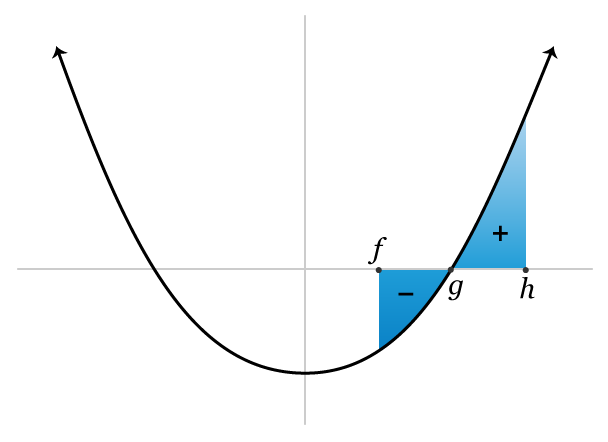
The integral is positive above the x-axis and negative below the x-axis. Since area cannot be negative, make sure to add the absolute values of the integrals.
Calculate the total area between the curve and x-axis from the points x = 1, to x = 3.
Solution
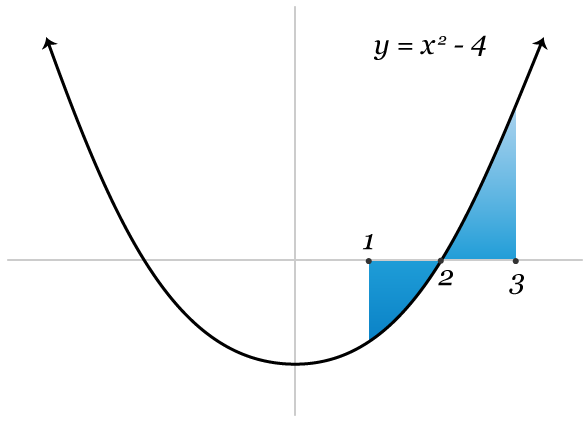 Make sure to split up the negative (x = 1 → 2) and positive (x = 2 → 3)...
Note that the net area would be...
Make sure to split up the negative (x = 1 → 2) and positive (x = 2 → 3)...
Note that the net area would be...
Calculate the area from the curve to the x-axis from x = 10 to 20.
Solution
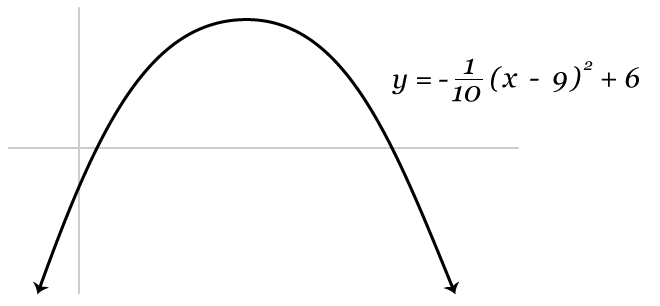 First find the x-intercept!
Find the x-intercepts using the quadratic formula...
Use x = 16.75 because it is between the points 10 and 20...
First find the x-intercept!
Find the x-intercepts using the quadratic formula...
Use x = 16.75 because it is between the points 10 and 20...
Then calculate the area with definite integration between 10 & 16.75, then 16.75 & 20...
Then calculate the area with definite integration between 10 & 16.75, then 16.75 & 20...
Area Between a Curve and a Straight Line
Calculate the area bounded by the x-axis, the y-axis, the line and the curve .
Solution
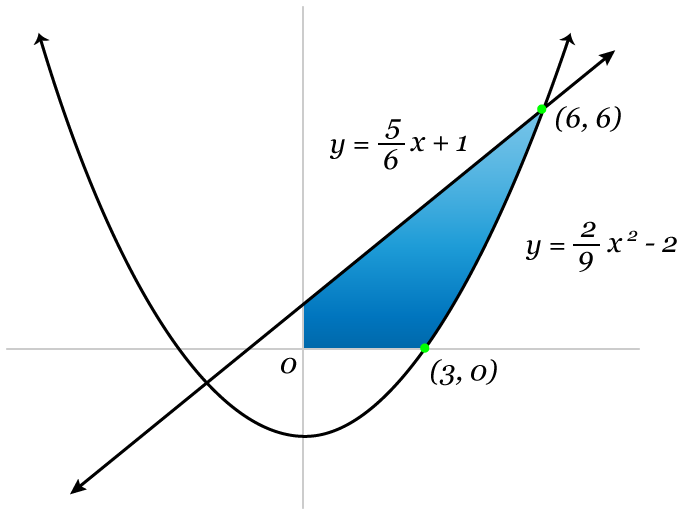
Subtracting like this will give you the area above the x-axis.
 Calculate the area under the straight line from x = 0 to x = 6. Then subtract the area under the curve from x = 3 to x = 6.
Calculate the area under the straight line from x = 0 to x = 6. Then subtract the area under the curve from x = 3 to x = 6.
Now calculate the area between the curves, bounded only by the y-axis and the lines. This includes the area between the curves below the x-axis. Use the alternate method with the equation below.
Solution
 (The common method is to separately calculate the area above the axis and the area below the axis, and then add them together.)
(The common method is to separately calculate the area above the axis and the area below the axis, and then add them together.)
An alternate method will include the area between the curves below the x-axis making sure to subtract the area below the axis, which is negative...
 Calculate the area under the straight line from x = 0 to x = 6. Then subtract the area under the curve from x = 3 to x = 6.
Calculate the area under the straight line from x = 0 to x = 6. Then subtract the area under the curve from x = 3 to x = 6.

(The common method is to separately calculate the area above the axis and the area below the axis, and then add them together.)
An alternate method will include the area between the curves below the x-axis making sure to subtract the area below the axis, which is negative...
An alternate method will include the area between the curves below the x-axis making sure to subtract the area below the axis, which is negative...
Area Between Trig Functions
Calculate the area between the two trig functions from to .
Solution
Sketch, and see the upper function is
Area Between Trig Functions
Calculate the area between the two trig functions from to , given that the functions intersect at x = 0.8205
Solution
Sketch and see that is the upper function from x = 0 to 0.8205 and that is the upper function from x = 0.8205 to .
Separate this into two parts to calculate the left and right side...
And the other part,
Now add the parts back together,
Motion/Kinematics
Motion Graphs
The slope on a position-time graph represents:
Solution
Video
Differentiating displacement from a position-time gives the gradient, which is the velocity, proof...
Position is a vector quantity.
The area (underneath the plotted line or curve) on a velocity-time graph represents:
Solution
Video
The definite integral (gives area) on a velocity-time gives displacement, proof...
Displacement is a vector quantity.
The slope on a velocity-time graph represents:
Solution
Video
Differentiating (taking the derivative) gives the gradient on a velocity-time graph, which gives acceleration, proof...
The area (underneath the plot) on an acceleration-time graph represents:
Solution
Video
Integrating (anti-differentiation) for the area on an acceleration-time graph gives the velocity, proof...
Solving Motion Problems
Given the formula map below....
Velocity is the _________ of _________.
Solution
Velocity is the integral of acceleration.
The motion of a car can be represented with the equation below, where v(t) is velocity in m/s. Calculate the distance travelled by the car from 5 to 10 seconds.
Solution
The car travels in the same direction so you can just do...
Calculate the distance travelled for the function in m/s, from 0 to 33 seconds.
Solution
Notice there is no change in direction (no x-intercept in the given interval).
! But you see the function exists in the negative range (below the x-axis). When v(t) is negative you can do...
This is basically determining s(t) and substituing the points 0s and 33s...
! But you see the function exists in the negative range (below the x-axis). When v(t) is negative you can do... This is basically determining s(t) and substituing the points 0s and 33s...
Solving Motion Problems
Given the velocity function below, in m/s...
Determine when the object reverses direction.
Solution
The direction reverses when v(t) = 0, at the x-intercept...
Determine the position function, s(t)
Solution
Displacement is the integral of velocity...
Calculate the displacement from 0s to 2s.
Solution
The displacement is alway relatively simple to calculate as the change in position, s(t)
Calculate the distance travelled from 0s to 2s.
Solution
Careful here! If the direction reverses at ⅔s, then there is some extra distance travelled...
Plug in the values at the start, reverse, and end times. Best solved with a sketch so you can visualize...
 Visually you can see the total distance travelled, taking into account the reverse in direction, is...
Visually you can see the total distance travelled, taking into account the reverse in direction, is...
Plug in the values at the start, reverse, and end times. Best solved with a sketch so you can visualize...
 Visually you can see the total distance travelled, taking into account the reverse in direction, is...
Visually you can see the total distance travelled, taking into account the reverse in direction, is...
